YOU ARE INVITED

SPECIAL SECTION
2023 SLOW WEDDINGS ARE IN SEASON
Five nuptials with all locally grown blooms

ALSO IN THIS ISSUE
FLORI COGNOSCENTI NON-TRADITIONAL BOUTONNIÈRES
FEAST & FLORA IS WHERE WE BLOOM
FLORA CULTURE
TRACY YANG'S
HMONG-AMERICAN FLORAL JOURNEY
SLOW FLOWERS HERO GINA LETT-SHREWSBERRY
CELEBRATIONS | SPRING 2023
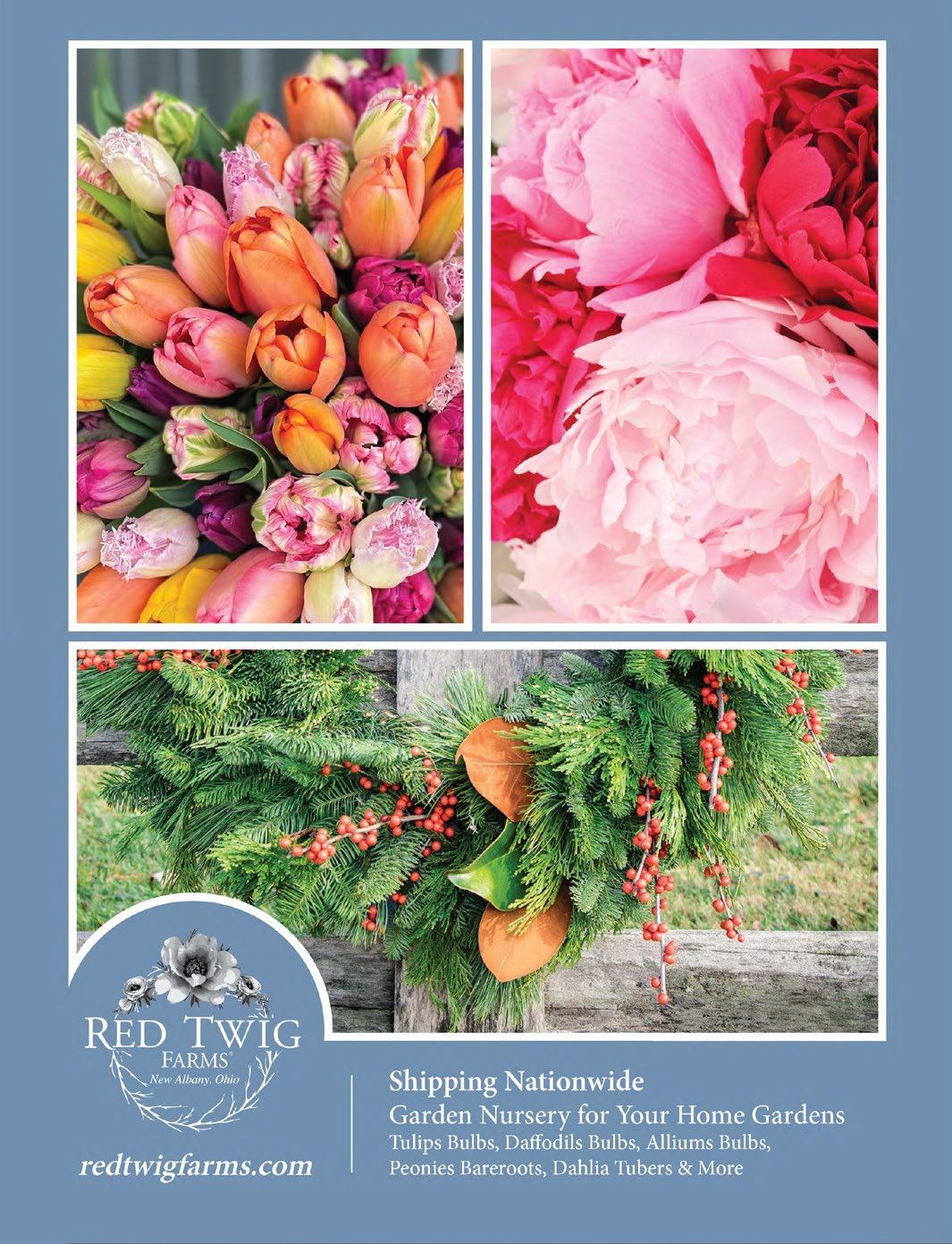
EDITORIAL DIRECTOR
Debra Prinzing
CREATIVE DIRECTOR
Robin Avni
COPY EDITOR
Brenda Silva
CONTRIBUTORS
Mara Littlefield, Alison Ellis, and Emma May Dixon
PHOTOGRAPHERS
Bloom Photography, Emma May Dixon, Emily Gude, Genevieve Leiper Photography, Charity Hope, Jacilyn M. Photography, Jesi Lee Photography, Justin and Lauren Photography, Missy Palacol, and Stella Kelsie
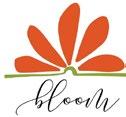
ON THE COVER
For an October ceremony in Virginia, Little Acre Flowers provided sunflowers, dahlias, and companion blooms to echo floral décor and personal flowers. Cake design by Jason Reaves, executive pastry chef and cake designer at the Salamander Resort and Spa.
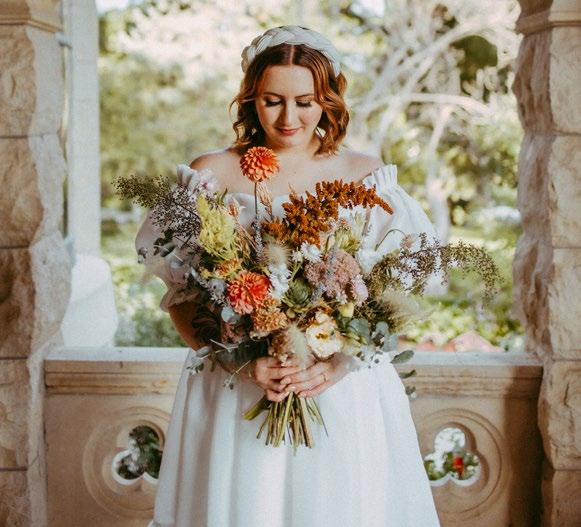
LITTLE ACRE FLOWERS
littleacreflowers.com
@littleacreflowers
COVER PHOTOGRAPHER
Genevieve Leiper Photography, genevieveleiper.com
@genevieveleiperphotography
2023 by SLOW FLOWERS JOURNAL and BLOOM Imprint. All rights reserved.

No part of this publication may be reproduced, stored in a retrieval system or transmitted, in any form or by any means, electronic, mechanical, photocopying, recording or otherwise, without prior written permission of the publisher.
It’s the season for Celebrations and Ceremonies, each of which is elevated with locally grown blooms. We are delighted to treat you to an issue filled with design ideas for weddings—grand or intimate! Thanks to the gifted flower farmers and sustainably minded floral artists in the Slow Flowers Community, we’re sharing 10 nontraditional boutonnière designs and five real weddings with a decidedly local aesthetic.
This issue also celebrates the Slow Flowers practitioners whose work influences their communities. We profile Gina Lett-Shrewsberry of Inspirations by Gina, a not-so-quiet trailblazer for beauty, intentionality, and inclusion. Farmer-florist Maya Littlefield—who participated in our recent Slow Flowers Creative Writing Course— has shared a special essay about her influential grandmother, who instilled in her a passion for flowers and art.
A mother’s instruction and guidance plays a large role in flower farmer Tracy Yang’s story of her Hmong-American traditions, featured in our Flora Culture series. Where We Bloom series visits Feast & Flora in Charleston, South Carolina, where Laura Mewbourn’s retail space brings the flowers she grows closer to her community and customers.
Next up: Our Summer 2023 Botanical Couture issue, out in time for American Flowers Week.
here comes the ...
SLOW FLOWERS JOURNAL 3
Debra + Robin
JESI LEE PHOTOGRAPHY
spring.
EMMA MAY DIXON An Oregon-based flower farmer and designer who has a love for photography. Through her lens, Emma captures the visual language of the garden, the home, and everyday moments of life as it unfolds. These are the moments she chases as she works with her family, and helps tell their stories. Emma’s photography is featured in “Furrow & Flour” (BLOOM Imprint, 2023), and she is the co-host of “A Blooming Good Time” podcast. @emma.may.dixon
MAYA LITTLEFIELD. Maya is a ceramicist, floral designer, farmer, and sometimes-photographer based in Burlington, Vermont. She has also been a backpacking guide, a vegetable farmer, an outdoor educator, and a ski instructor – always spending as much time as possible outdoors. It was through these various lines of work that Maya realized she could combine her creativity and love of nature through floral design and flower farming. Maya currently works as a florist and farm manager at West Lane Flowers in Colchester, Vermont. @mayalittlefield
ALISON ELLIS. A Vermont-based floral designer and author of “Falling into Flowers: A Step-by-Step Guide to Today’s Modern Wedding Business” (Wildflower Media, 2020). She founded realflowerbusiness.com to share step-by-step business training that helps build long-term success, including "Flower Math," which teaches florists how to maximize profit margins. realflowerbusiness.com
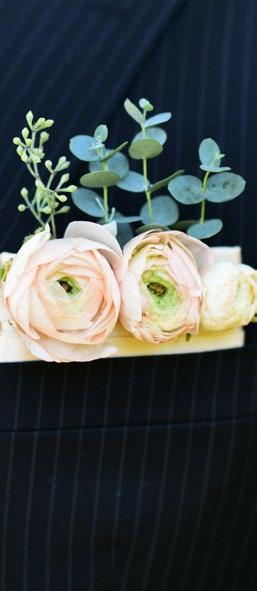



MISSY PALACOL. A Seattle-based portrait and brand photographer, digital marketing expert, speaker, and travel junkie. She teaches people and companies how to capture their authentic visual brand, and how to leverage social and digital media to grow their businesses. In 2014, Missy left her job in corporate marketing and struck out on her own with Missy Palacol Photography, capturing rich and memorable images for individuals, families, events, and brands. missypalacol.com

CONTRIBUTORS
SPRING 2023 4
6
26
SLOW WEDDINGS you are invited. to our first Slow Weddings issue –16 pages that express love and marriage through flowers both charming and creative. From Virginia and Maryland, to Nebraska and Maryland, locally grown flowers and sustainable designs elevate these beautiful ceremonies.

43
COLOR REPORT ode to the taupe rose.


THE BUSINESS OF FLOWERS destinations.
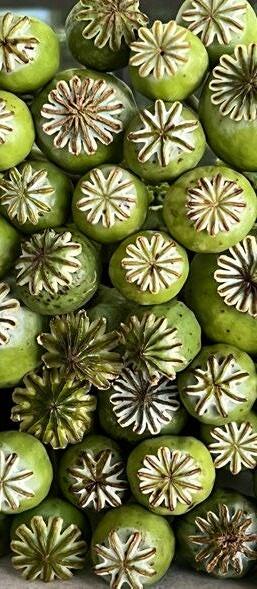
SLOW FLOWERS JOURNAL 5 48 17 20 departments special section
COGNOSCENTI uncommon lapels. 6 WHERE WE BLOOM feast & flora. 13 SLOW FLOWERS HEROES inspirations by gina. 17 FOREVER FLOWERS modern everlastings. 20 FROM THE HEART my grandma's garden 48 FLORA CULTURE the art of paj ntaub. 56
FLORI
45 20
26
Q: How do you upgrade the boutonnière?
Uncommon floral adornments for lapels, buttonholes, and pockets
Designer Ellen Frost incorporated unique biking elements like tiny wheel cogs into the boutonnières, a nod both to the groom’s favorite pastime and the venue, a park close to biking trails. “We used simple elements— gomphrena and rosemary— to let the cogs shine,” she explained.
Kris Bennett is a fan of pocket boutonnières for their simplicity and ease. “They stay where they are placed and photos are always great!” Ranunculus and succulents lay flat and are attached to ribbon. Design one to two days before the event, and use a hydration chamber to keep things fresh.

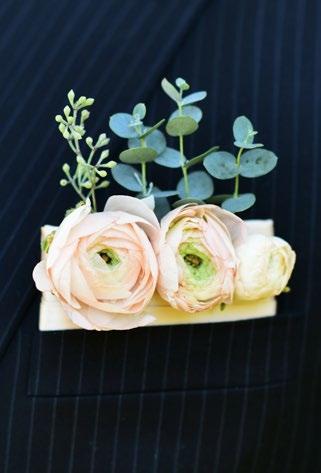
For a black-and-white wedding, Sarah Wagstaff wanted a timeless, classic floral look. The boutonnière elements come from SUOT Farm (variegated Fatsia japonica; fern tips; a flowering plum branch tip, and boxwood), and from MV Blooms, which grew the white anemone. It’s tied with a simple black ribbon to complement the palette.

FLORI COGNOSCENTI SPRING 2023 6
ELLEN FROST LOCAL COLOR FLOWERS BALTIMORE, MARYLAND WEBSITE INSTAGRAM
BRITTANY RILEY PHOTOGRAPHY
KRIS BENNETT KRISANTHEMUMS HERMISTON, OREGON WEBSITE INSTAGRAM
SARAH WAGSTAFF SUOT FARM AND FLOWERS BURLINGTON, WASHINGTON WEBSITE INSTAGRAM
SWEET LIFE PHOTOGRAPHY
BRIAN SLANGER WEDDINGS
SRINI PERERA
KREATIVEHANDS | WOODLAND HILLS, CALIFORNIA WEBSITE INSTAGRAM
Srini Perera was delighted that the groom wore a floral tie, so she created a mini version of the bridal bouquet for his lapel. The design includes dried bittersweet berry, pepper berry, castor bean pods, leptospermum pods, nandina foliage, sea holly, and 'Miss Piggy' rose with outer petals removed.
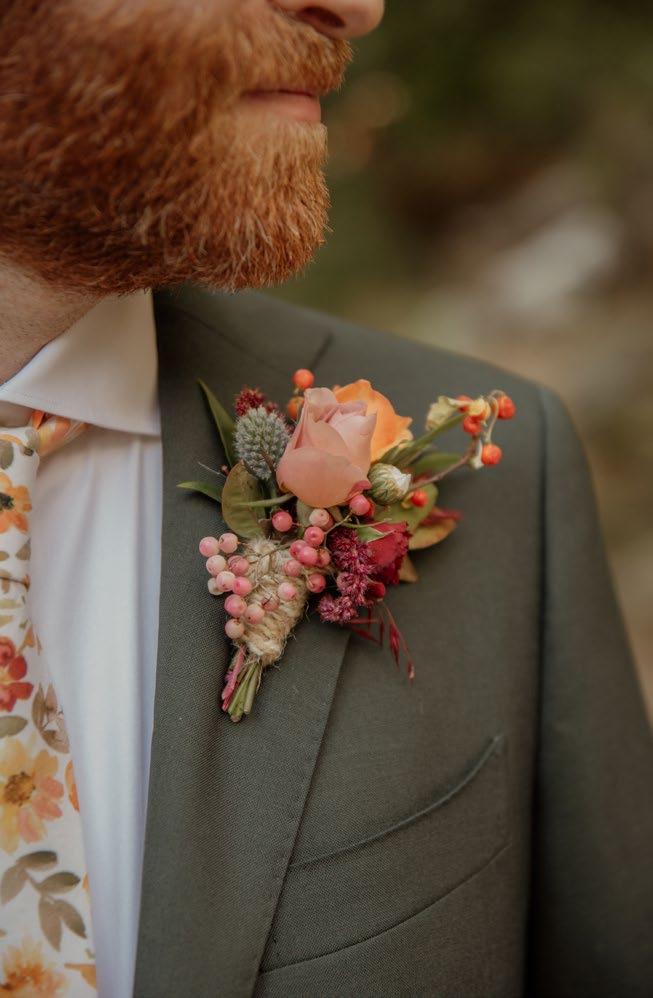
XENIA D'AMBROSI
SWEET EARTH CO. | POUND RIDGE, NEW YORK WEBSITE INSTAGRAM
Created for a wedding with a white and green palette, this Sweet Earth Co. boutonnière includes astrantia and viburnum foliage (grown by the designer), California-grown spray roses and ruscus foliage. “Most of the time, we tend to design in groups of three, but for this boutonnière each of the elements— the accent flowers, focal flowers and greenery—is grouped in pairs,” Xenia said. The resulting design is quite handsome!

SLOW FLOWERS JOURNAL 7
CHRISTY KENDALL
SWEET EARTH CO.
PILAR ZUNIGA
GORGEOUS + GREEN | OAKLAND WEBSITE INSTAGRAM
To complement a “mushroom and colorful fairyland-themed wedding,” Pilar Zuniga included hydroponic mushrooms in hair crowns, bouquets, and boutonnières. The groom donned a pocket square of mushrooms and flowers, while his attendants’ bouts included mushrooms, dianthus, belladonna, craspedia, and echinops. A vintage sewing pin with an orange head held everything in place.

SANDY FIGEL
VERBENA FLORAL | SEATTLE, WASHINGTON WEBSITE INSTAGRAM
These modern boutonnières accented a wedding with an all-succulent floral palette. “It was fun to collect a variety of different succulents—in green, silver, and golden colors—and deconstruct them for all of our pieces, including the bouquets, corsages, centerpieces, and boutonnières,” Sandy said. The boutonnières’ twine stem wraps coordinated with natural textiles for a simple, elegant style.
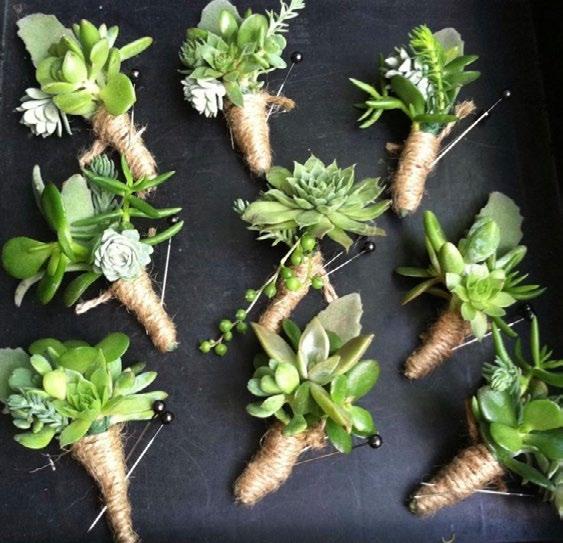
FLORI COGNOSCENTI SPRING 2023 8
GORGEOUS AND GREEN
VERBENA FLORAL
SUSAN LARDER CAROL MILLETT FORAGED FLORALS
HARRISTON, NOVA SCOTIA WEBSITE INSTAGRAM
For a spring, forestinspired wedding, a "nest boutonnière" embodies the intimate nature of the event. The woven willow means change, growth, and new beginnings. The live moss and rock lichen provide soft textures. The designers say this piece was prepared well in advance of the ceremony. The flat, woven back of the nest rests tightly against the lapel and is easily affixed with floral pins. Alpine succulents and miniature daffodils are the ideal size and scale, tucked into the basket-like structure and providing beautiful contrast to the groom's navy suit to herald the season.

SLOW FLOWERS JOURNAL 9
SAMSON PHOTOGRAPHER
“This pocket square was designed for the wedding of dear friends, a female same-sex couple,” said Blair. “With a little more pizzazz than a regular boutonnière, it is a perfect floral style for anyone wearing a suit (male or female; or gender non-conforming members of the wedding party).” Ingredients include spray roses, delphinium, and larkspur blossoms, thistle, brunia berries, and umbrella fern.
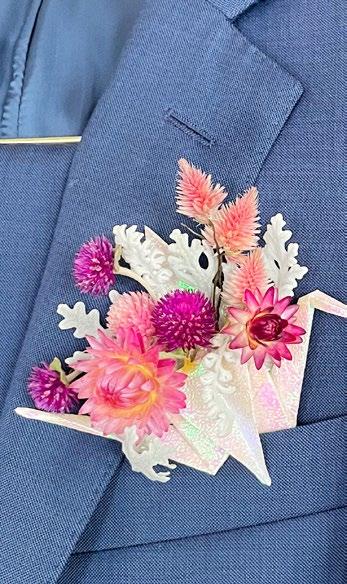
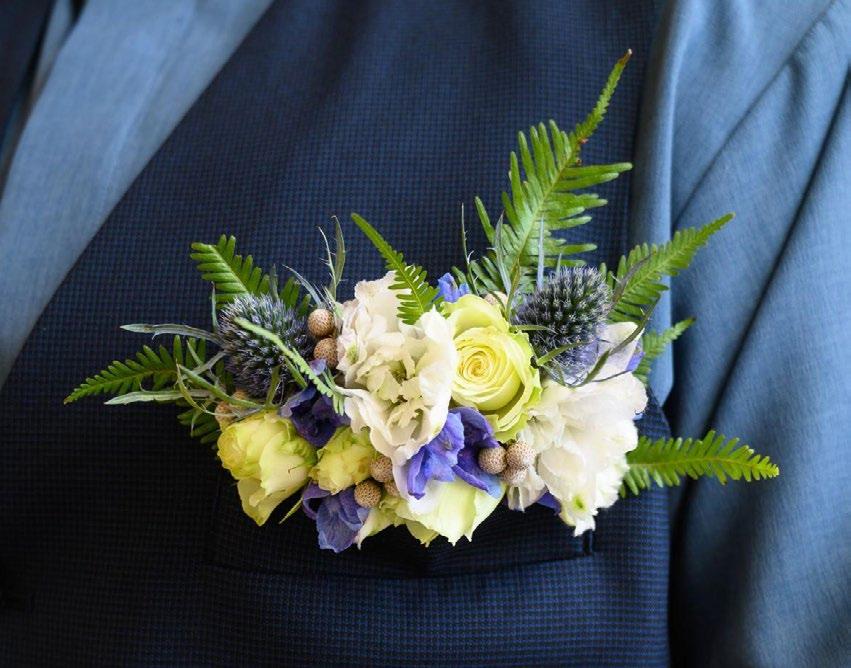
FLORI COGNOSCENTI SPRING 2023 10
BLAIR LYNN SWEET BLOSSOMS LLC | IJAMSVILLE, MARYLAND WEBSITE INSTAGRAM
CHRISTA VECCHI
SWEET BLOSSOMS LLC
VECCHI
"Cranes are majestic birds that mate for life, symbolizing loyalty, honor, good fortune, and longevity," explains floral designer Christa Vecchi. For complementary boutonnières worn by her clients, a gay couple, she began with origami cranes as the foundation. The everlasting botanicals represent enduring love, and include dusty miller (Senecio cineraria), celosia, gomphrena, and strawflower (Xerochrysum bracteatum).
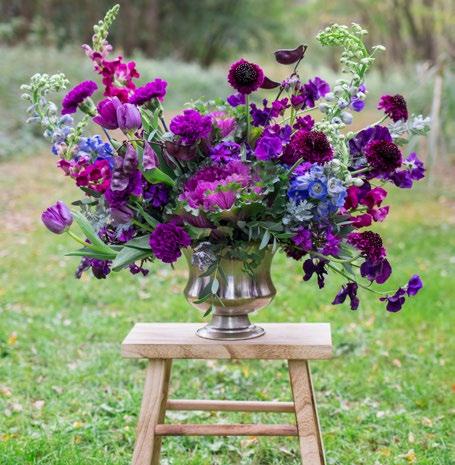
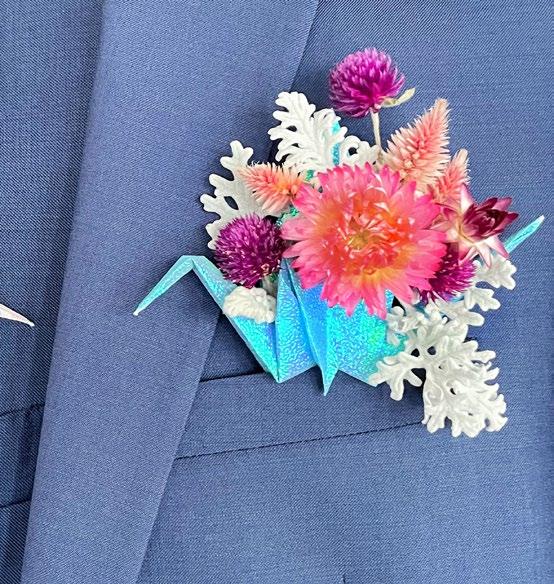

SLOW FLOWERS JOURNAL 11
THE
UNION, VIRGINIA
INSTAGRAM dvflora.com | 800-676-1212 We Deliver Freshness
CHRISTA
CEDARMERE IN
BLUE RIDGE | FREE
WEBSITE
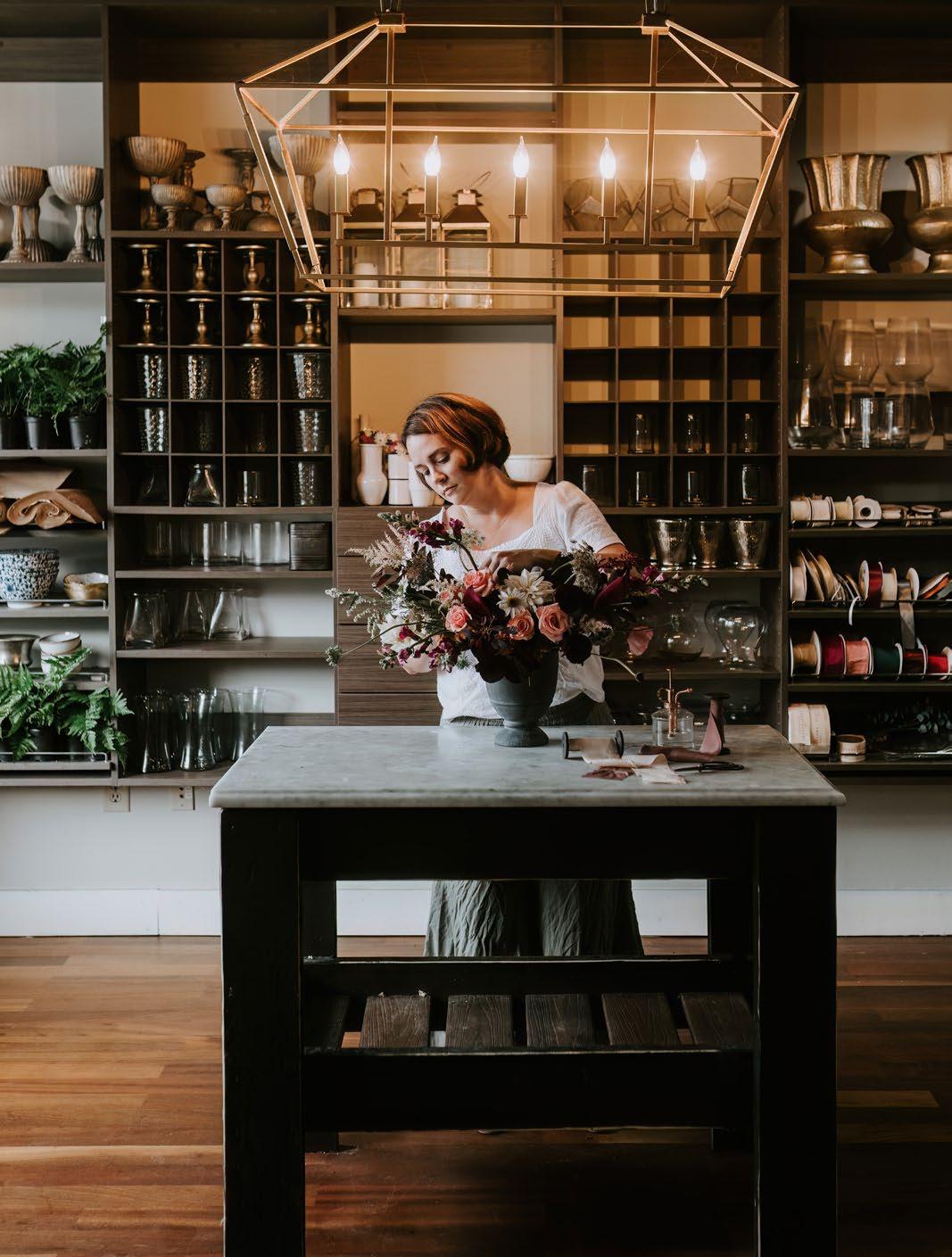
feast & flora.
charleston, south carolina
Based in Charleston, South Carolina, Feast & Flora is a hybrid enterprise that reflects the dual passions and seasonal aesthetic of its farmer-florist owner, Laura Mewbourn.
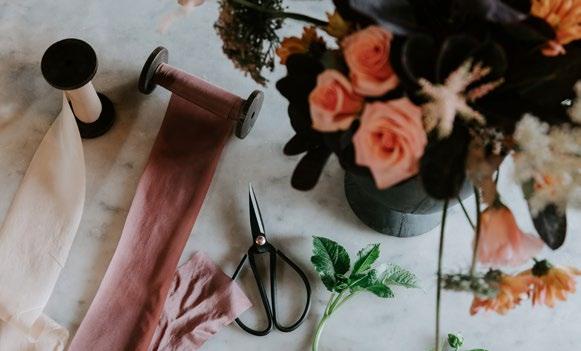

She founded Feast & Flora as a flower farm in 2016, and the business has evolved from growing specialty-cut flowers for wholesale sales, to offering wedding and event floral design since 2018, to establishing a 1,400-square-foot retail flower and gift shop in 2022.
“Opening this retail space helped diversify us,” Laura explained. “I was designing in a detached, single-car garage at my home. It was an amazing space to have at the time when I needed it, but as weddings came back full force after the pandemic, it was just ridiculous trying to get anything done.”
At the same time, Feast & Flora’s retail business—including everyday orders from consumers and a few regular grocery accounts—spiked during the pandemic, creating another reason Laura needed more space. “I was getting retail orders that I had to turn down because I didn’t have room to hold that much product, nor did I have the labor to manage everything because I was doing most of the designs by myself,” she said.
SLOW FLOWERS JOURNAL 13
WHERE WE BLOOM BY DEBRA PRINZING PHOTOGRAPHY BY JUSTIN AND LAUREN PHOTOGRAPHY
Designing inspired florals and offering a curated selection of gifts and home décor
An online Feast & Flora shop was already in place prior to the physical retail opening, which allowed for a seamless transition to everyday flowers for delivery. “If a customer calls to order a dozen roses or something that indicates they are not directly familiar with our work, that prompts us to have a conversation with them, explaining more about who we are and why we are different,” Laura explained. “Most of our arrangements are ‘designer's choice,’ and some customers aren’t used to that. I use the phrase, ‘we pick the best of what's blooming’ repeatedly, because we give preference to seasonality and bloom quality.”
Feast & Flora leases three acres of farmland on Wadmalaw Island, located approximately 30 minutes outside of Charleston.
“We painted one of the inside walls black, which I just love,” she said. “I was going for this vibe that causes people to sort of gasp and rave over it when they come inside. It’s happy flowers against a dark, moody feeling.”
The elegant composition is reminiscent of a Dutch Masters’ still-life painting with vivid botanicals against a black canvas. Interior lighting includes a large, gilded fixture that hangs above one of the design tables; other pendant lights are suspended between the rafters. Freestanding fixtures are an eclectic mix, sourced from Facebook Marketplace or Laura's family pieces. One of her cherished fixtures is a table with legs salvaged from a baby grand piano, built by her greatgrandfather.
Laura found the space after potential leases on two other locations fell through. Previously occupied by a real estate office, the building has a symmetrical façade, with large picture windows flanking two doors that face a busy thoroughfare. Inside, the wood flooring and ceiling-to-floor wall of built-in shelving was almost move-in ready. Laura installed an 80-square-foot CoolBot system and updated the building’s exterior with her signature evergreen palette, white trim, and signage.
“I had this mental image of placing one of our workbenches in a window, almost like a candy shop or a bakery where people walking past can stop and watch someone doing the work; or a chef’s table at a restaurant, where you can see your meal being prepared, which amounts to a completely different experience when you’re eating that dinner,” Laura said. “I wanted the same thing with our flowers, so customers would feel free to come in and have a conversation with the designers and learn more about what we’re doing.”
Having conversations with customers helps to develop long-lasting ties, Laura noted. It often starts when a shopper wanders into Feast & Flora. “We get a lot of rush-hour traffic in the mornings and evenings, so people may see us in passing and then stop
SPRING 2023 14
The retail shop and design studio call a popular Charleston neighborhood their home, sharing customer foot traffic with adjacent restaurants and other independent retailers.
WHERE WE BLOOM
one day because they’re curious. When they walk into our shop, I want them to see something different from that older concept of a florist. Our merchandise is as much of a draw as our flowers. To me, it’s all about curating a nice collection of gifts, items made by local artisans, and other things that I love.”
Laura’s personal aesthetic and love of giftgiving means she stocks jewelry, paper items, specialty and gourmet food staples, home goods, and plants.
“We wanted to create space for impulse shopping, and that means serving a broad audience with a wide variety, and price points between handmade items and lessexpensive items,” she added. Rental vases are organized on shelves and cubbies that

flank one wall; not surprisingly, customers also want to shop from this inventory.
Laura relies on Heather Duby-Tharpe, her full-time designer/manager, to run the daily operations, which allows her to spend more of her time at the farm.
“Basically, I now run three businesses,” she said, noting that each is focused on such a different market: the flower farm; wedding and event design; and retail floristry. “I’m finding myself less inclined to sell my flowers wholesale and instead, want to focus on our retail services. Of course, that would let me grow more unusual flowers, and smaller quantities of unique varieties, which is what I’ve wanted to do all along. I feel like the universe put me in this spot, and this is exactly where I want to be!”
SLOW FLOWERS JOURNAL 15
WEBSITE | INSTAGRAM

PHOTOGRAPHY BY BLOOM PHOTOGRAPHY
gina lett-shrewsberry
inspirations by gina | sacramento, california
Launching a floral studio after working in entertainment banking and public sector finance for decades felt to Gina LettShrewsberry like coming home. "I was making great money in finance, but it didn’t give me joy,” she recalled.
Inspirations by Gina began with event design for the Black Student Club at her son’s school, and soon expanded into planning weddings—including for ceremonies at San Francisco City Hall—which approved Gina as a preferred vendor.
The planning business was originally her “side hustle,” intended to generate additional income after the state of California (her employer at the time) asked employees to take a 15% pay cut. While booking wedding clients was a success, Gina often felt frustrated when DIY couples bought flowers in bulk without having a plan for arranging them.
SLOW FLOWERS SUMMIT
June 26-27, 2023
SLOWFLOWERSSUMMIT.COM
Gina Lett-Shrewsberry will speak at the 6th Slow Flowers Summit as part of the Floral Design Track on Day Two. Her presentation, “Sourcing Local Flowers for Your Wedding Designs,” will be accompanied by a floral design demonstration.
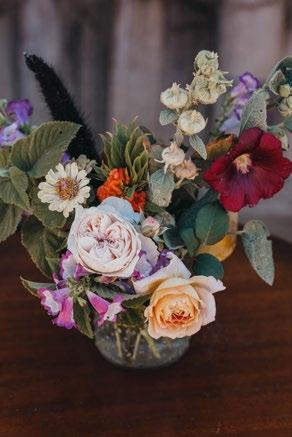
A colleague recommended that Gina study floral design at American River College, which offered programs in hospitality and horticulture. With an expanded set of design skills and training gained by freelancing for other florists, Gina inched her way toward full-time floral design.
“I had a hybrid business from 2017 to 2019. Wedding planning
SLOW FLOWERS HEROES BY DEBRA PRINZING
"I couldn’t let things fall apart, so I often found myself pulling things together."
SLOW FLOWERS JOURNAL 17
was good money, but the imposter syndrome loomed as I watched others getting published, receive speaking invitations, and be recognized in other ways."
Encouraged by friends and people in her church community to embrace her natural gift for floral design, Gina dropped wedding planning entirely and began exclusively promoting herself as a floral designer in October 2019. Since she was already a preferred wedding planner for San Francisco City Hall, Gina went through the vetting process to be added to its list of preferred florists.
“San Francisco is known for its sustainability, and because the City Hall is a historic building there are all sorts of rules for events there.”
Mother’s Day in May 2020, and floral delivery sustained me through the pandemic.”
Like many who enter floral design as a second career, Gina acknowledges the sense of comfort that connects her with gardening influences from her late mother, Juanita Dasher Lett.
“My mom was an avid gardener; I mean, she could throw something in the dirt and it would take root,” she recalled. “She was ahead of her time, collecting coffee grounds, tea leaves, and eggshells to compost –everything went back into the ground. Her sister, my aunt Arlene Dasher Saunders, was a nurse, but she would come home from work to tend her beautiful rose garden in Sacramento.
Just a few months later, though, the pandemic prompted City Hall to close. “Weddings represented 80% of my business,” Gina reported. “At the time, no one knew how long the pandemic would last, but when a colleague asked me, ‘Why don't you deliver flowers?’ I started doing what I already was doing; I changed to designing for individuals instead of for weddings. My first clients were for
They knew about sustainability before it was hip. They knew how to repurpose!”
Her values influence her approach to flower sourcing, responsible foraging, and sustainable design – including foam-free mechanics and repurposing vases. Gina buys at the San Francisco Flower Market from Mayesh Wholesale Florist, and direct from flower farms throughout Northern California. She incorporates green mechanics learned from designers Susan McLeary and T.J. McGrath at past Slow Flowers Summit conferences.
SLOW FLOWERS JOURNAL 18
SLOW FLOWERS HEROES
Raised in San Francisco, Gina’s aesthetic is inspired by the California landscape. “The sustainability I learned growing up is present in who I became as an artist. I grew up in a garden, so my aesthetic is seasonal and garden-inspired.
I love creating the feeling of crawling through the wildflowers.”
The accomplishments that Gina once admired in other florists are now part of her own resume. Inspirations by Gina designs for corporate events and venues; frequently appears on local television as a lifestyle expert; teaches at home and garden shows; and was the first Black-owned floral studio to design for San Francisco’s deYoung Museum’s “Bouquets to Art” event in 2022.
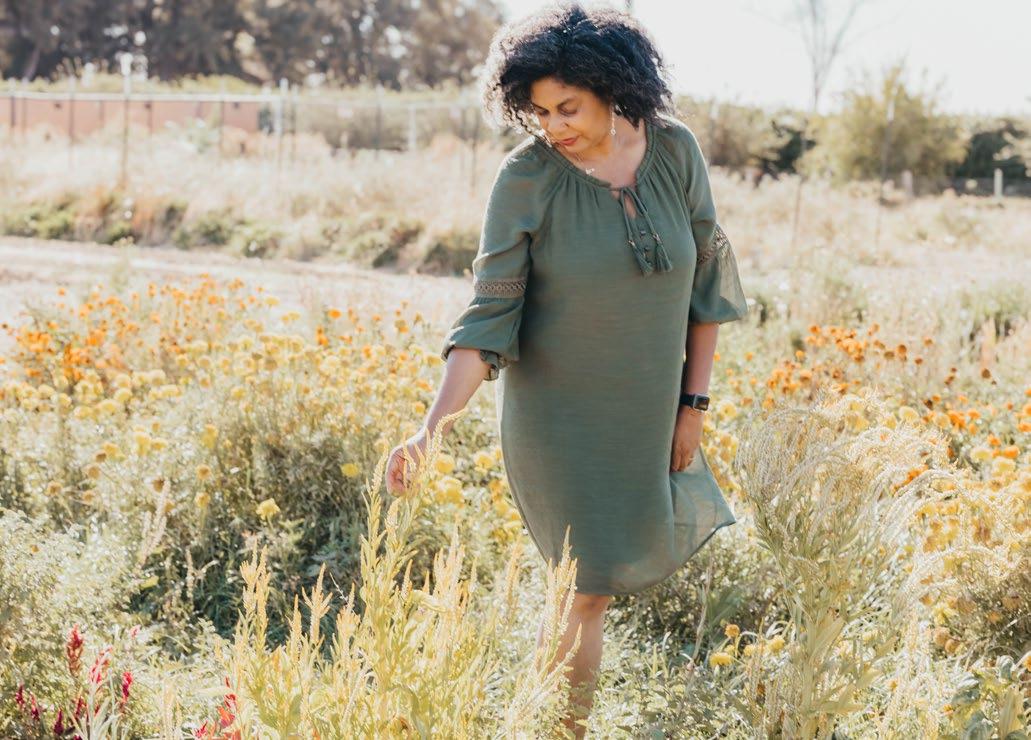
In June, Gina will share her approach to sustainable floristry and discuss her sourcing philosophy at the Slow Flowers Summit.
Gina’s joy of building an intentional life in flowers is expressed beautifully in a statement she wrote for her website: “We create memorable experiences that promote happiness. We believe in purposeful design and repurposing those designs whenever possible. We love elegance without being overblown and simplicity that’s not shabby or gaudy. Our design style is romantic, serene, and thought-provoking with a nod to Mother Nature.”
WEBSITE | INSTAGRAM
SLOW FLOWERS JOURNAL 19
modern everlastings.
These aren’t faded or dusty dried flowers
A version of this story first appeared online at Johnny's Selected Seeds.
Like the fashion industry’s penchant for updating popular silhouettes from decades past, the floral marketplace is rediscovering the incredible value and design potential of dried botanicals. Today’s growers can choose from a much wider lineup of ingredients for their dried-flower programs, and florists welcome the increased variety of colors, textures, and forms for their designs.
We spoke with four Slow Flowers Society members, farmer-florists who discuss their approaches to growing flowers for drying, as well as how they use dried flowers as an important revenue stream in their enterprises. This article covers three phases in the lifecycle of dried botanicals: Selection and Planning; Growing, Harvesting, and Drying; and Designing, Pricing, and Selling.
Our experts include: Bethany Little of Charles Little & Co. (Eugene,
Oregon); Heather Henson of Boreal Blooms (Cold Lake, Alberta, Canada); Meryl Gartside of Blue Lobster Flower Farm (Cape Cod, Massachusetts); and Tiffany Anderson of Earth & Seeds Flower Farm (Reno, Nevada).
SELECTION AND PLANNING
Dried flowers have been a significant part of Boreal Blooms’ product mix for the past six years, said Heather Henson. “Our growing season in northern Alberta is extremely short for fresh flowers – it’s about three months long. It’s not possible for me to make a good living with fresh flowers alone. I was looking for a way to make my farm viable, and it turns out that dried flowers do really well here in our cold, dry winter climate. I have been able to slowly create a market and a fan base of people who love dried flowers, and our dried bouquets are a mainstay of the business.”
Similarly, Reno’s short growing season has inspired Tiffany Anderson to expand her emphasis on dried flowers at Earth & Seeds. “As we shift into fall and winter
here in the high desert, we no longer have fresh flowers. So, it’s all about everlastings, as well as grasses and pods, and other things you leave in your fields that age when temperatures turn colder. Dried flowers are seasonal flowers. When we turn these ingredients into home décor, it gives us the ability to talk to our community about what seasonal flowers are. We discuss the high environmental cost of imported flowers, and embrace what we have in our climate and environment right now.”
Some of Tiffany’s favorite annuals include cornflower, nigella, and poppies grown for their pods; perennial Veronica, herbs, and hydrangeas are also top Earth & Seeds crops. “I also tried growing broom corn last year, which was really cool to play with, especially for wreaths. And I found blushing lantern (Silene vulgaris) to be so useful.”
Over the past seven years, Meryl Gartside has changed the focus of what Blue Lobster Flower Farm
FOREVER FLOWERS BY DEBRA PRINZING
SPRING 2023 20
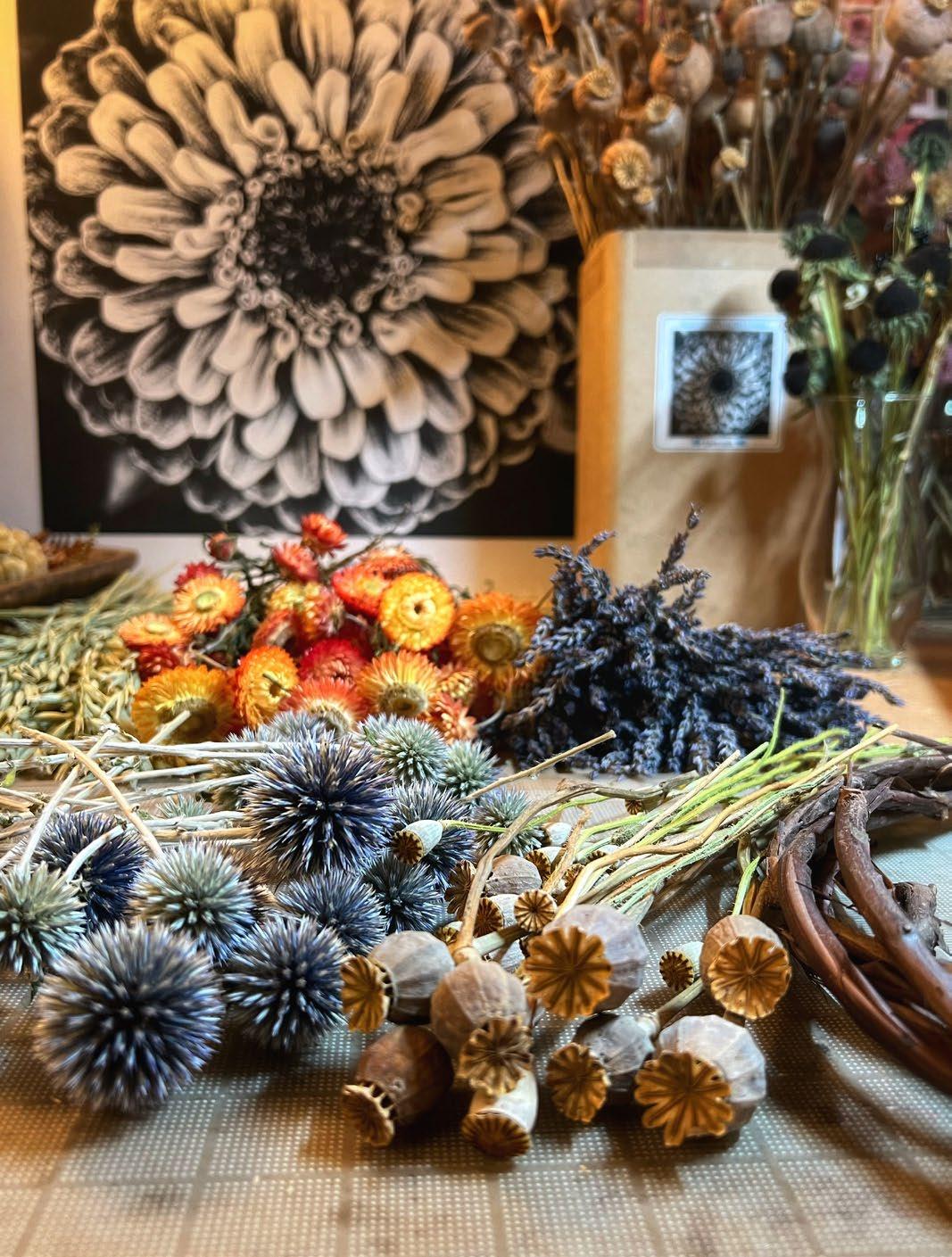
MERYL GARTSIDE, BLUE LOBSTER FLOWER FARM
FRONT, LEFT TO RIGHT: ECHINOPS AND POPPY PODS; BACK, LEFT TO RIGHT: STRAWFLOWER AND LAVENDER

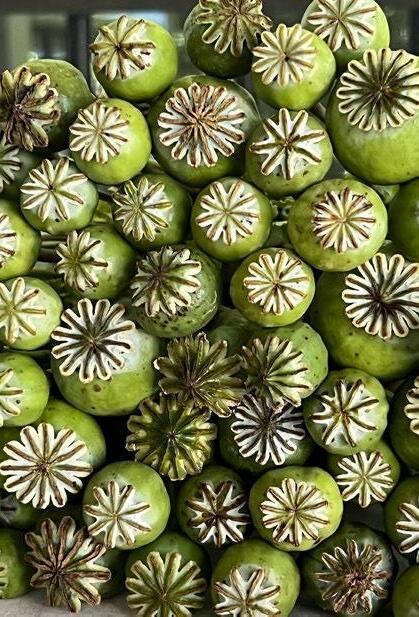


SPRING 2023 22
CHARLES LITTLE & CO. LAVENDER
BLUE LOSTER FARM POPPY PODS
EARTH AND SEEDS FLOWER FARM DRIED WINGED EVERLASTING, 'VEGMO SINGLE' FEVERFEW, YARROW, GRASSES
BLUE LOSTER FARM DAHLIAS
grows. “Now, when I’m planning my crops, I’m selecting for what will dry well. And it’s not just strawflowers and gomphrena. I’m drying crops that most people don’t know you can dry. With the right conditions, when harvested at the right time, you can dry so many types of flowers.”
At Boreal Blooms, Heather produces masses of annuals including larkspur, statice, strawflowers, celosia, and sunflowers. “These are basic, bulk ingredients that I use in everything, so I need a ton of them,” she said. "For new flower farmers, or for those just getting started with drying, annuals provide an easy way to jump in –they are so economical! You can take so many cuts from a single stem of larkspur, for example. A single stem of statice produces one or two mains stem for the bouquet, and then all the side shoots, which I can use for flower crowns, boutonnieres or wreaths. And I keep everything I prune for other projects.”
At Charles Little & Co., Bethany Little joked that her mantra, “Everything Dries,” should be printed on a T-shirt. “People call me all the time and ask whether a specific flower can be dried and I tell them – yes, everything
dries,” she said. “But you have to grow the right crops, harvest at the right time, and dry in the right environment.”
GROWING, HARVESTING, & DRYING
At Charles Little & Co., during the “first wave” of dried flowers in the 1990s, Charles erected a threestory barn, devoting the third level and its vaulted loft to flower drying. “It gets over 100 degrees there and we have ventilation and lots of fans,” Bethany explained.
The right stage of harvest is closely related to color fastness and flower stability. “Watch your crops carefully, because you’ll learn that everything has a specific ‘best harvest time’ for drying. We grow over 50 different varieties specifically to harvest only for drying – it’s not an afterthought.”
Bethany and others interviewed for this story mentioned that it’s best to cut strawflowers when the bloom is tight to avoid shattering. That’s because the flowers do tend to open after they are cut. “Many varieties, like the rose or pink ones, have fatter stems, which means there’s more energy to feed that bloom. Your flowers, in general, will keep maturing when hung,” Bethany said. Similarly, with ornamental grasses like miscanthus, the best harvest stage is when the blooms are silky, tight, and have not begun to drop pollen. After mostly drying flowers on rafters in her Cape Cod basement—with a dehumidifier to reduce moisture—and after experimenting with hanging flowers to dry in her home’s hot attic, Meryl now uses a 9-by-12foot farm shed to dry her flowers. “It’s the perfect environment,” she explained. “There is no direct sun because the shed is nestled in the trees; it’s warm in the summer with everything closed up. I no longer have to climb up on rickety stairs because we have rigged a drop ceiling of a cattle panel that can be raised and lowered to hang bunches.”
Bloom size and petal color are important factors in how a flower looks when dried. Heather plucks the largest flower heads
SLOW FLOWERS JOURNAL 23
FOREVER FLOWERS
"Now, when I’m planning my crops, I’m selecting for what will dry well. And it’s not just strawflowers and gomphrena.
I’m drying crops that most people don’t know you can dry."
of her ranunculus, peonies, and lisianthus to ensure they dry well. “Things shrink by 30% to 50% when you dry them, so I know that the biggest flowers make the best dried flowers. A sunflower is going to shrink a lot, so I cut the enormous sunflowers that I probably would never put in a fresh bouquet to dry. And I pick the most perfect, beautiful peonies to dry.”
Meryl also considers petal hue as a factor in drying. She said peach and blush blooms often appear faded, while a flower that’s vivid when fresh will dry in subtle patinas. “I dry a lot of dark purples and burgundies, and any brightcolored dahlia or zinnia will usually give a good result when dried,” Meryl explained. Some flowers
hold their white color when dried, she noted, including strawflower, gomphrena, feverfew, larkspur, and ammobium.

DESIGNING, PRICING, & SELLING
As a former graphic designer Meryl considers dried botanicals as art supplies for wreaths and other Blue Lobster Flower Farm products. “I love playing with color and texture,” she said. “So many dried flowers can be fantastically colorful. They might be a little muted, but I’ve also grown to love that look. Sometimes there’s a total color shift when something is dried. You can’t plan for or hybridize these subtle and beautiful shades of color.”
Meryl feels that her one-of-a-kind dried flower wreaths (rather than ones made from a recipe) have added value. While the Instagram
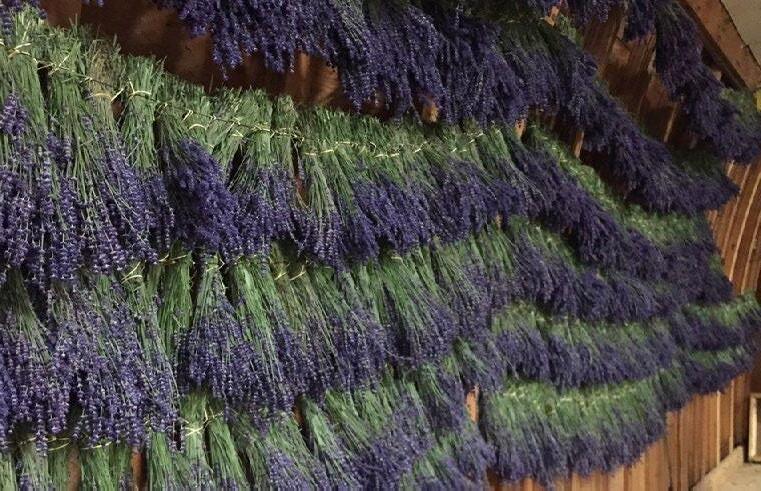
photo of her all-echinops wreath generated more than 7,000 likes a few years back, and while she is always asked to make similar ones, that’s not what excites her as a designer. “I’m not in it for that. I want to be creative,” she said.
Boreal Blooms’ reputation for dried wedding bouquets has become almost a year-round niche for Heather Henson. Her distinctive designs do not resemble dried bouquets of past decades. She removes all of the foliage and side stems from each floral element in order to make a compact, spiral, hand-tied bouquet.
“Dried wedding bouquets are an underserved niche, especially here in what I think is the most beautiful province in Canada, where people love outdoor weddings with the Rocky Mountains as their backdrop.
SPRING 2023 24
BOREAL BLOOMS MIXED BOUQUETS WITH SUNFLOWERS
CHARLES LITTLE & CO. LAVENDER
Dried bouquets are well suited for snowy, winter weddings, but my customers want them year-round, so I now sell dried flower bouquets for summer weddings. A bouquet made from dried flowers is an automatic keepsake,” she said.

Earth & Seeds’ florist customers buy from Tiffany on a year-round basis, including nigella, poppy pods, ammobium, strawflower, and gomphrena. “I can also sell these dried varieties in summer, because they add such textural elements to their designs.”
In general, Tiffany said she adds a 18-20% markup on her dried crops. “That reflects the extra time it takes to dry and store flowers after I’ve harvested them.”
All of these farmer-florists take care to educate customers about the shelf life of the dried flowers they purchase. “My wreaths certainly could last longer, but I tell people to come back in one year to buy a new wreath, because they deserve it,” Meryl joked. “A hair dryer on the low, cool setting can blow away any dust, but over time, the flowers will fade.”
Heather provides a care card with each custom dried bouquet. “It talks about keeping flowers out of the sun and away from cats. And I suggest customers keep their dried bouquets in a low-humidity environment and free of dust.”
EVERYTHING DRIES
Tiffany Anderson believes dried flowers underscore the message of seasonality. “You have to grow it to show it, and what we grow helps

to get people excited about flowers and nature, especially in the fall and winter.”
There is nothing more sustainable than finding an after-life use for a fresh flower that you may have in excess, or that you plant specifically to harvest and dry. At the very least, the experiences of these growers are a strong encouragement for you to experiment with growing, cutting, and drying a wide variety of stems from your fields or vases. Let beauty live on with a new purpose.
CHARLES
EARTH + SEEDS | WEBSITE
BLUE LOSTER FARM | WEBSITE
BOREAL BLOOMS | WEBSITE
SLOW FLOWERS JOURNAL 25
EARTH AND SEEDS FLOWER FARM DRIED CORN FLOWER, BASIL, TULSI, ARTICHOKE, HYDRANGEA, LAVENDER
CHARLES LITTLE & CO. DRIED FLOWER ARRANGEMENT
LITTLE & CO. | WEBSITE
YOU ARE INVITED
Thoughtful wedding florals nurture memories and convey meaning with the freshest, most beautiful blooms.
In our first Slow Weddings collection, we spotlight five ceremonies designed with all local and domestic botanicals.
Since the origins of the Slow Flowers Movement, we have advocated for weddings festooned with local botanicals. Seasonality, sense of place, and sustainability signify the values of our flower farmers and floral artists, traits also appreciated by their clients — couples who understand how their flower choices for ceremony and celebration are time-markers of a special day.
It used to be that a bouquet of just-picked roses or a nosegay of herbs tucked into a buttonhole were considered quaint; that instead, exotic and faraway blooms signified extravagant luxury. But things have changed, and here in North America, we have the proliferation of boutique flower farms to thank for providing designers with a greater selection of flowers, foliages, vines, and branches — during more months of the year than ever before.
SLOW WEDDINGS SPRING 2023 26
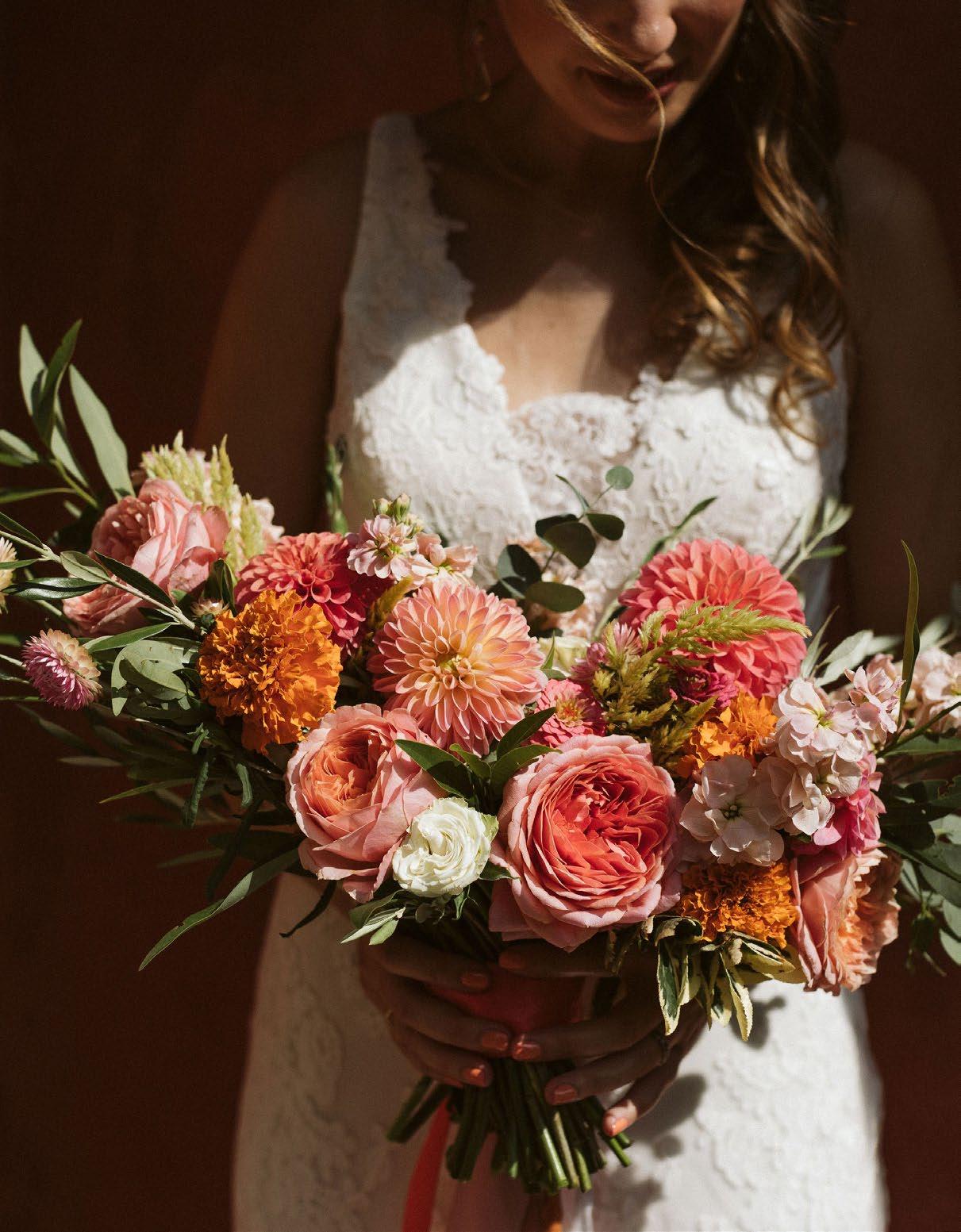
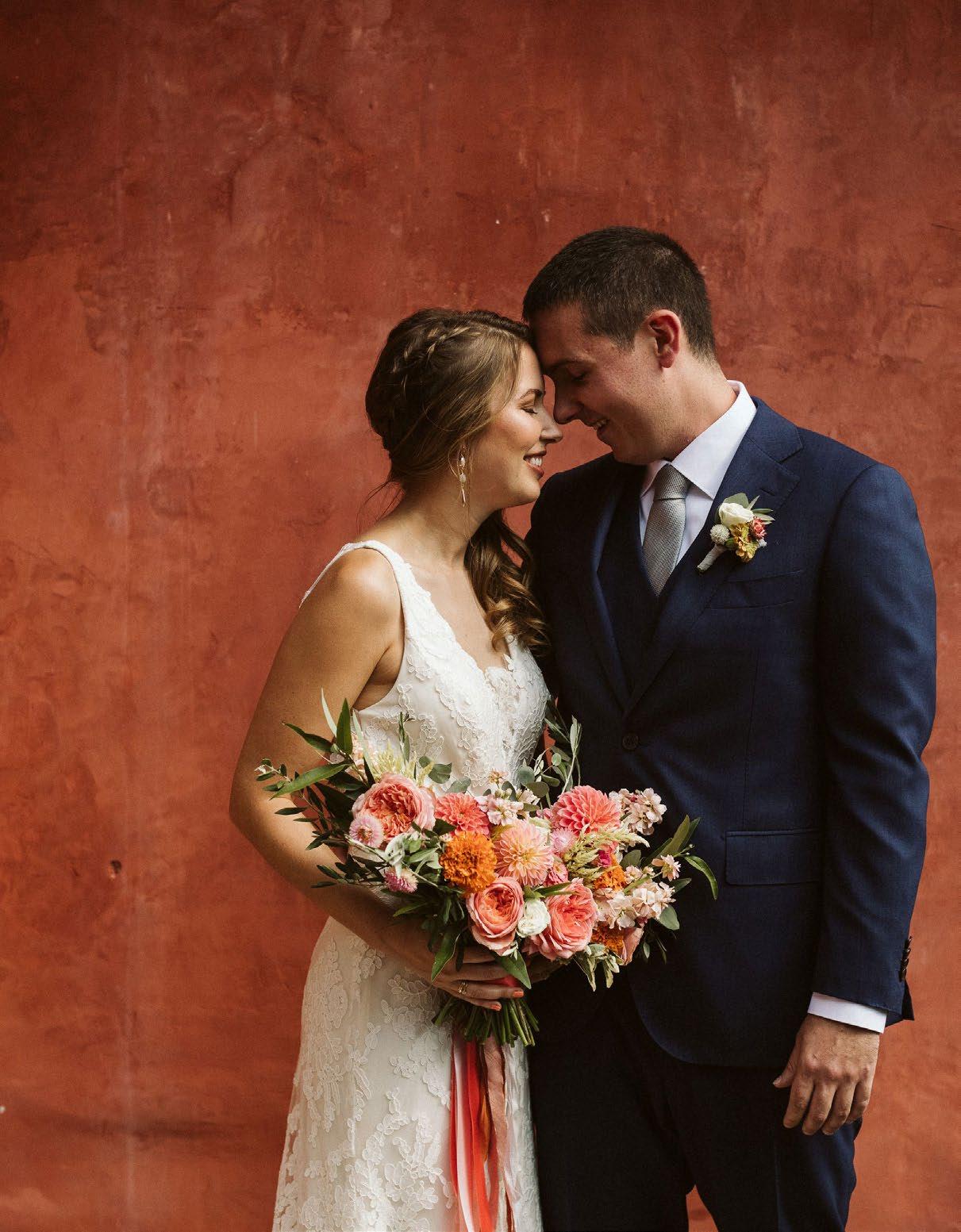
SWEET BLOSSOMS
The bride's heart was set on springtime and 'Coral Charm' peonies, but the pandemic meant rescheduling to fall. "We effortlessly switched seasons,"says Blair Lynn of Sweet Blossoms LLC, who designed with 'Romantic Antike' garden roses, dahlias, stock, zinnias, strawflowers, and marigolds in sunset and melon hues. "You don't have to have a certain flower to do the wedding. You need a good color palette and confidence in your florist."
FLORAL DESIGN: BLAIR LYNN, SWEET BLOSSOMS LLC, sweetblossomsllc.com | @thesweetblossoms
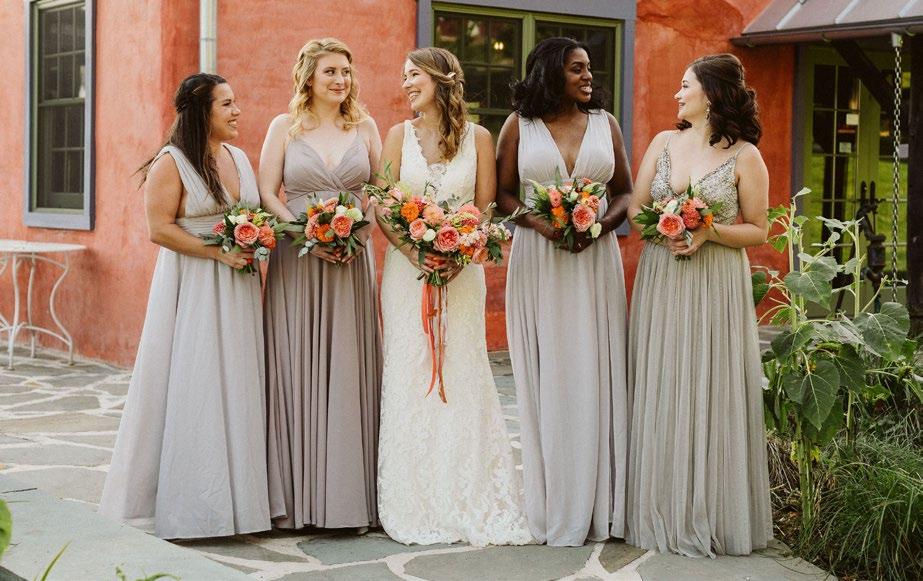
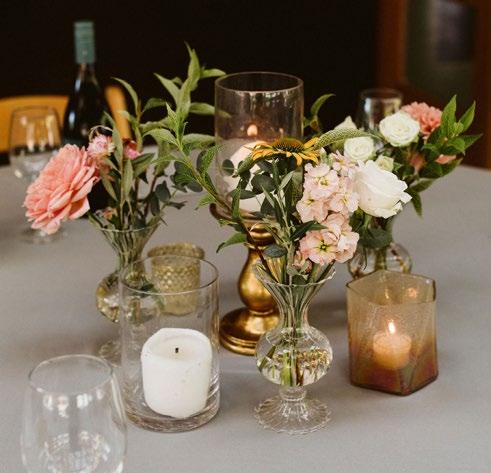
PLANNER: Allie DiGioia, @ofjoy_signatureevents
PHOTOGRAPHY: Emily Gude Photo, @emilygudephoto VENUE: ZigBone Farm Retreat, Sabillasville, Maryland, @zigbonefarmretreat
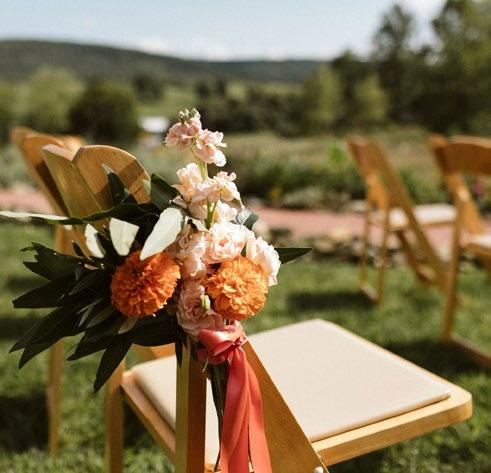
SLOW FLOWERS JOURNAL 29
For a June ceremony at Montana’s iconic Yellowstone Club, Remy Brault of Labellum created a contemporary floral statement with Montana-grown botanicals (plus anthurium from Hawaii). “The couple wanted the majority of their flowers to be as local as possible,” Remy said. When the bride specifically asked for “no pampas grass,” the designer instead used spires of local foxtail lilies for vertical drama to line the outdoor aisle in foam-free vessels.

FLORAL DESIGN: Remy Brault, Labellum, labellumflowers.com | @labellumflowers
FLORAL VASES: Lulu Pottery, @lulu.pottery PHOTOGRAPHY: Jacilyn M Photography, jacilynm.com
LOCATION: Yellowstone Club, Big Sky, Montana, yellowstoneclub.com | @yellowstoneclub
SPRING 2023 30
LABELLUM
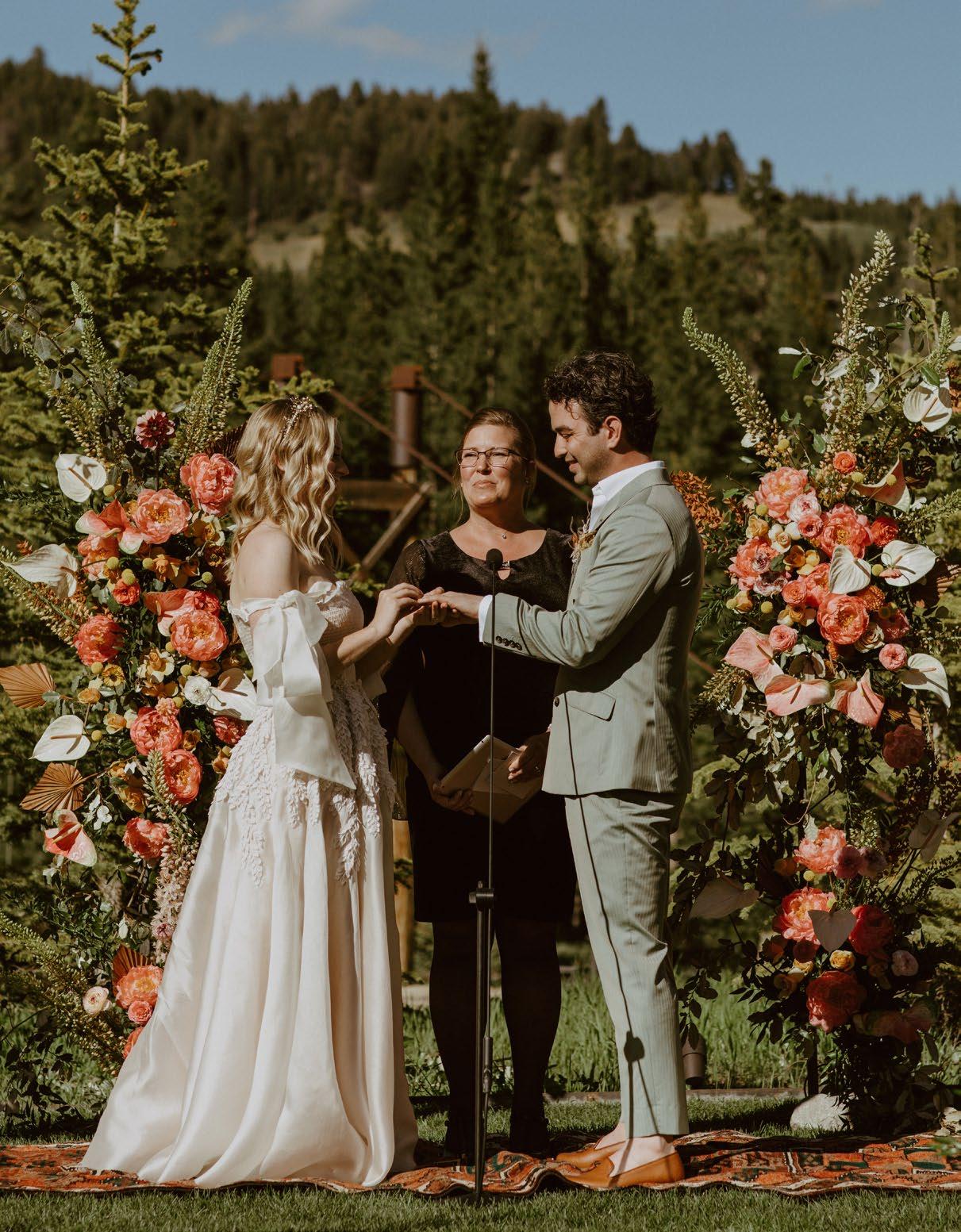
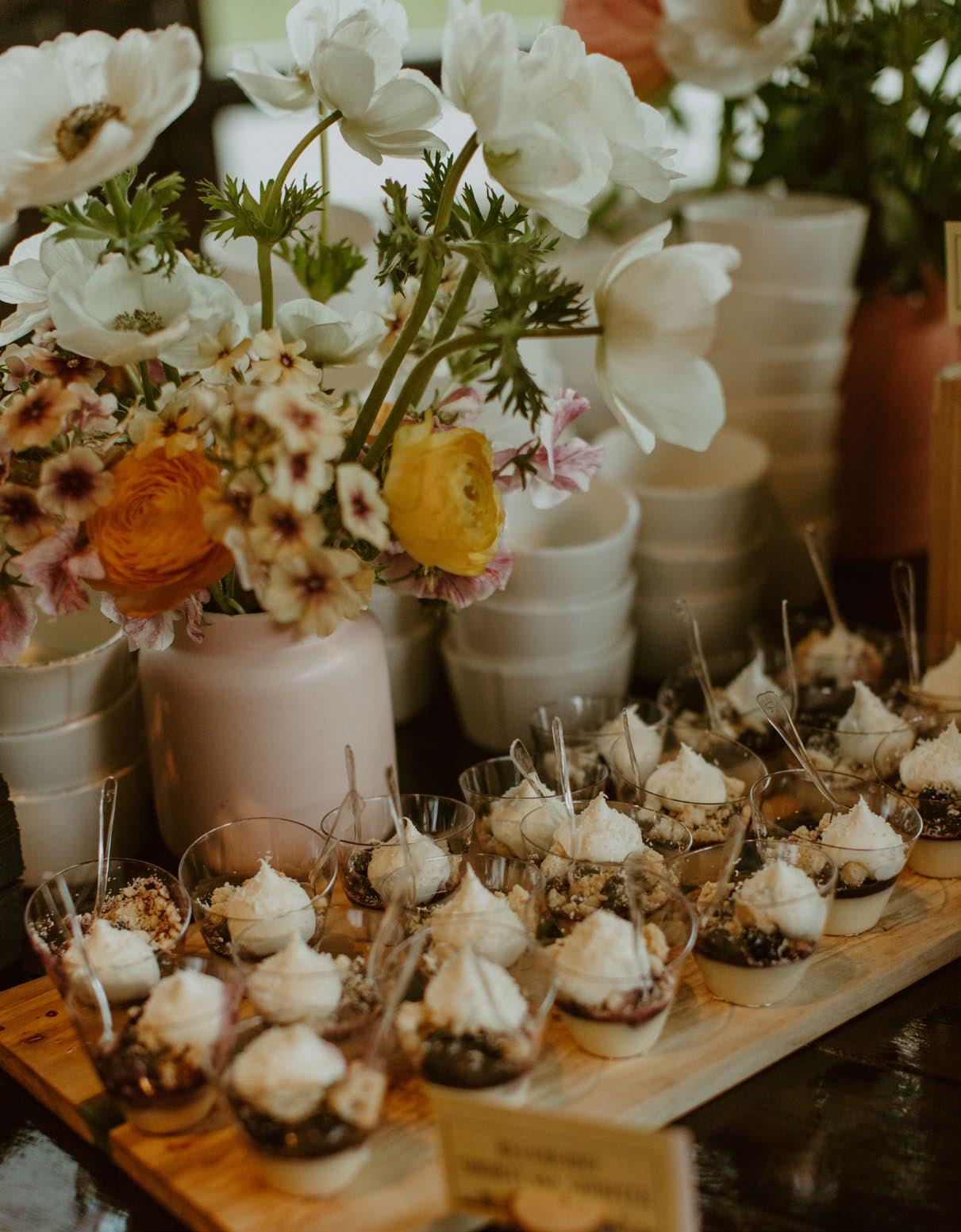
"I wanted the table arrangements to be asymmetrical with elements of Japanese ikebana, rather than traditional. Each design is different so that everywhere guests looked it was a different experience - nothing matches."
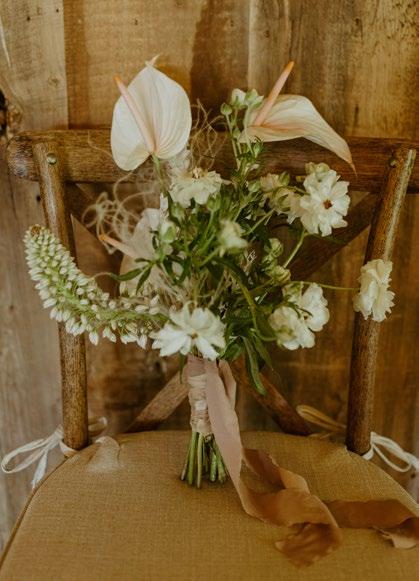
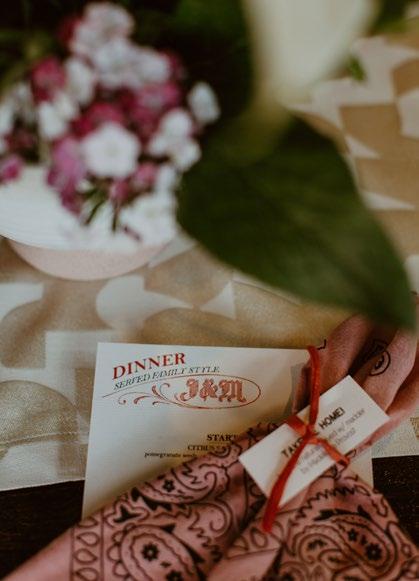

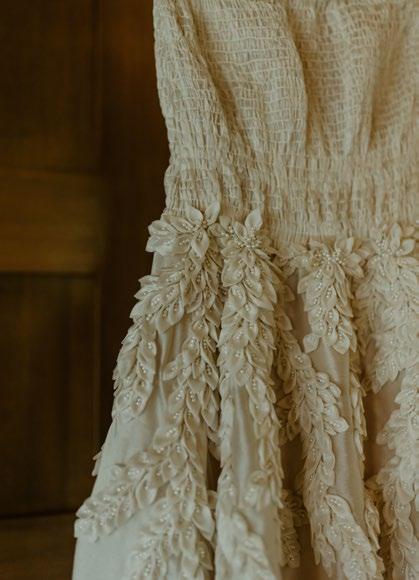
SLOW FLOWERS JOURNAL 33
LABELLUM
DISTRICT 2 FLORAL STUDIO
For an intimate September ceremony, florist Holly Lukasiewicz used 100% locally grown flora from farms across Eastern Nebraska and Western Iowa (Hen and the Hawk Flower Farm, The Swallow’s Nest Flower Farm, Sisu Gardens, and Long Walk Farm). “I love how the flowers mimic the natural environment of the celebration,” she said. The design features sedum, strawflower, lisianthus, dahlia, celosia, amaranthus, eucalyptus, lavender, feather top grass and succulents.
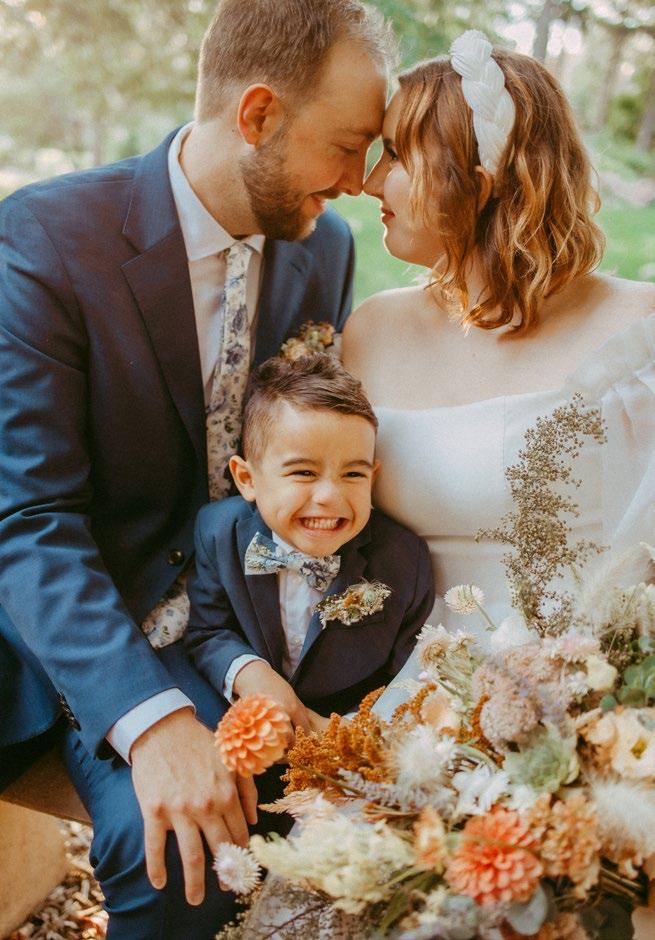
FLORAL DESIGN: Holly Lukasiewicz, District 2 Floral Studio, district2floral.com | @district2floral
PHOTOGRAPHY: Jesi Lee Photography, @jesilee.photography LOCATION: Joslyn Castle, @joslyncastle
SPRING 2023 34

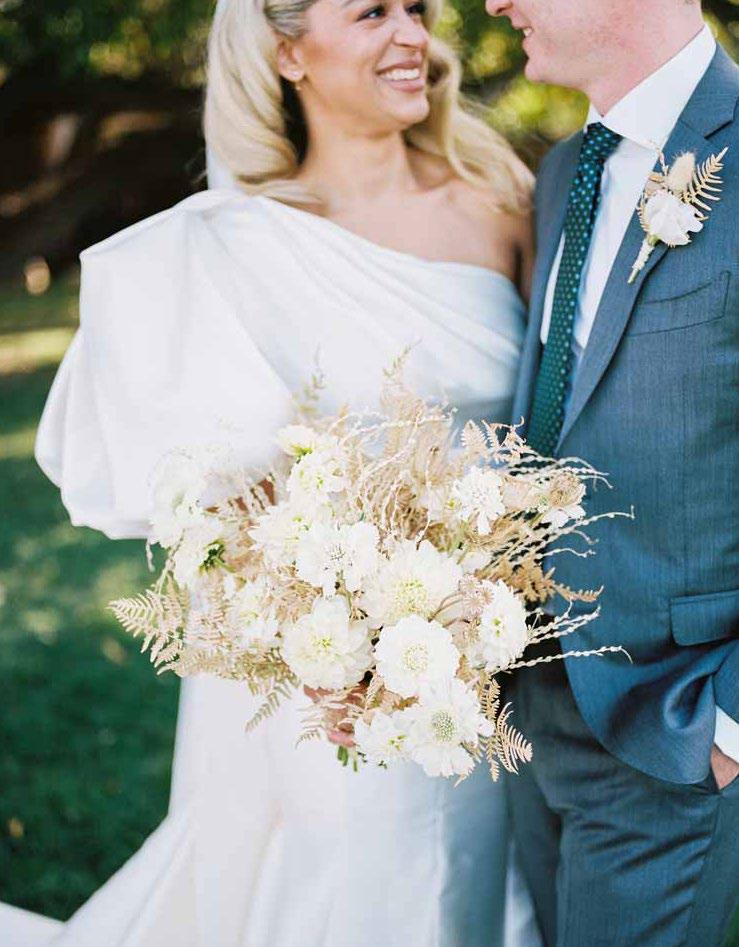
Farmer-florist April Vomfell combined dried elements with the late-season blooms harvested for an October ceremony from her farm, Flathead Farmworks. “I love offering fresh and dried combinations in the spring and fall, since we often have frost as late as mid-May and as early as mid-September,” she explained. Dried poppy pods and delicate dried ferns complement the wedding-white floral palette of just-picked dahlia, scabiosa, and strawflower blooms.
FLORAL DESIGN: April Vomfell, Flathead Farmworks, flatheadfarmworks.com | @flatheadfarmworks
PLANNER: Allie DiGioia, @ofjoy_signatureevents PHOTOGRAPHY: Stella Kelsie, @stella.k.photography
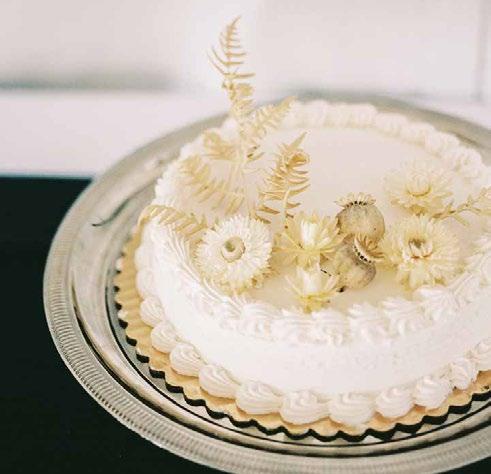
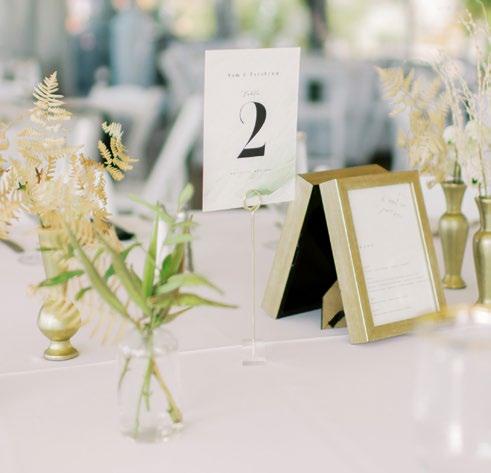
PLANNING/COORDINATION: Emily Summer Studios, @emilysummerstudios VENUE: Whitefish Lake Weddings, Whitefish, Montana, @whitefishlakeweddings DRESS: Solace London, @solacelondon
HAIR: Platinum Studios by Christina, @platinumstudiosbychristina MAKEUP: Marcela Cloud, @cloud_marcela

SLOW FLOWERS JOURNAL 37
FLATHEAD FARMWORKS
LITTLE ACRE FLOWERS
The groom’s favorite flowers were dahlias; the bride loved sunflowers. “It happened to be October when we could source both locally here in the DC-Maryland-Virginia region,” said Amber Flack of Little Acre Flowers. “The couple wanted oranges, pinks, and yellows – and we incorporated all the colors for a lush look.” The bride’s family has ties to Kenya, which inspired the custom textiles and handmade décor from African artists showcased at the reception.
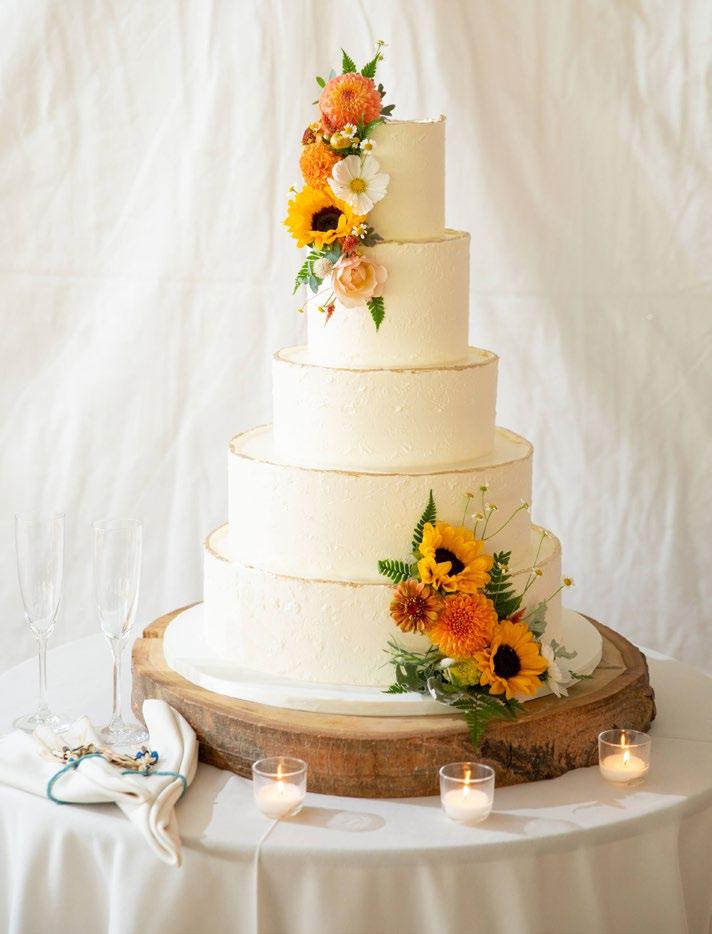
FLORAL DESIGN: Little Acre Flowers, littleacreflowers.com | @littleacreflowers
GOWN: Monique Lhuillier, moniquelhuillier.com | @moniquelhuillier
PHOTOGRAPHY: Genevieve Leiper Photography, genevieveleiper.com | @genevieveleiperphotography
LOCATION: Oatlands Historic House & Gardens, oatlands.org | @oatlands.historic.house
SPRING 2023 38
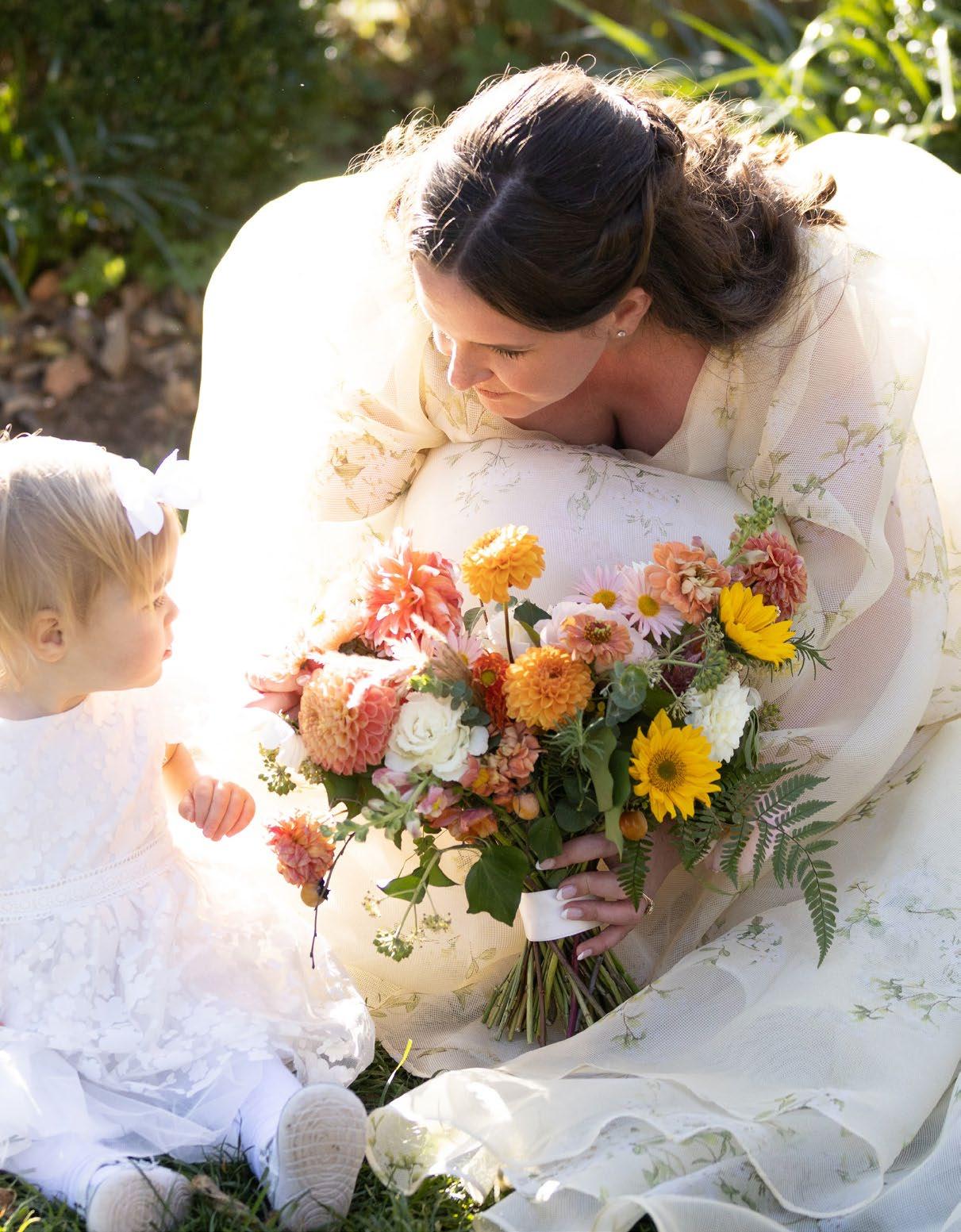

LITTLE ACRE FLOWERS
“The day was sunny, and we had the perfect temperature for an outdoor, fall wedding. Rather than designing a full chuppah, we complemented the large hydrangea bush at the front of the aisle, which worked out perfectly with the garden setting.”

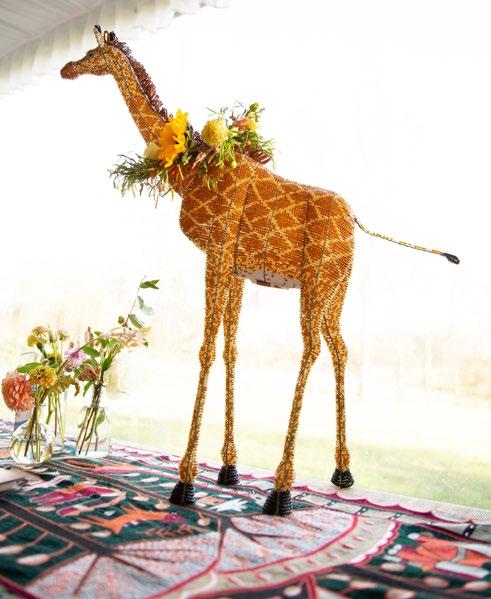

SLOW FLOWERS JOURNAL 41
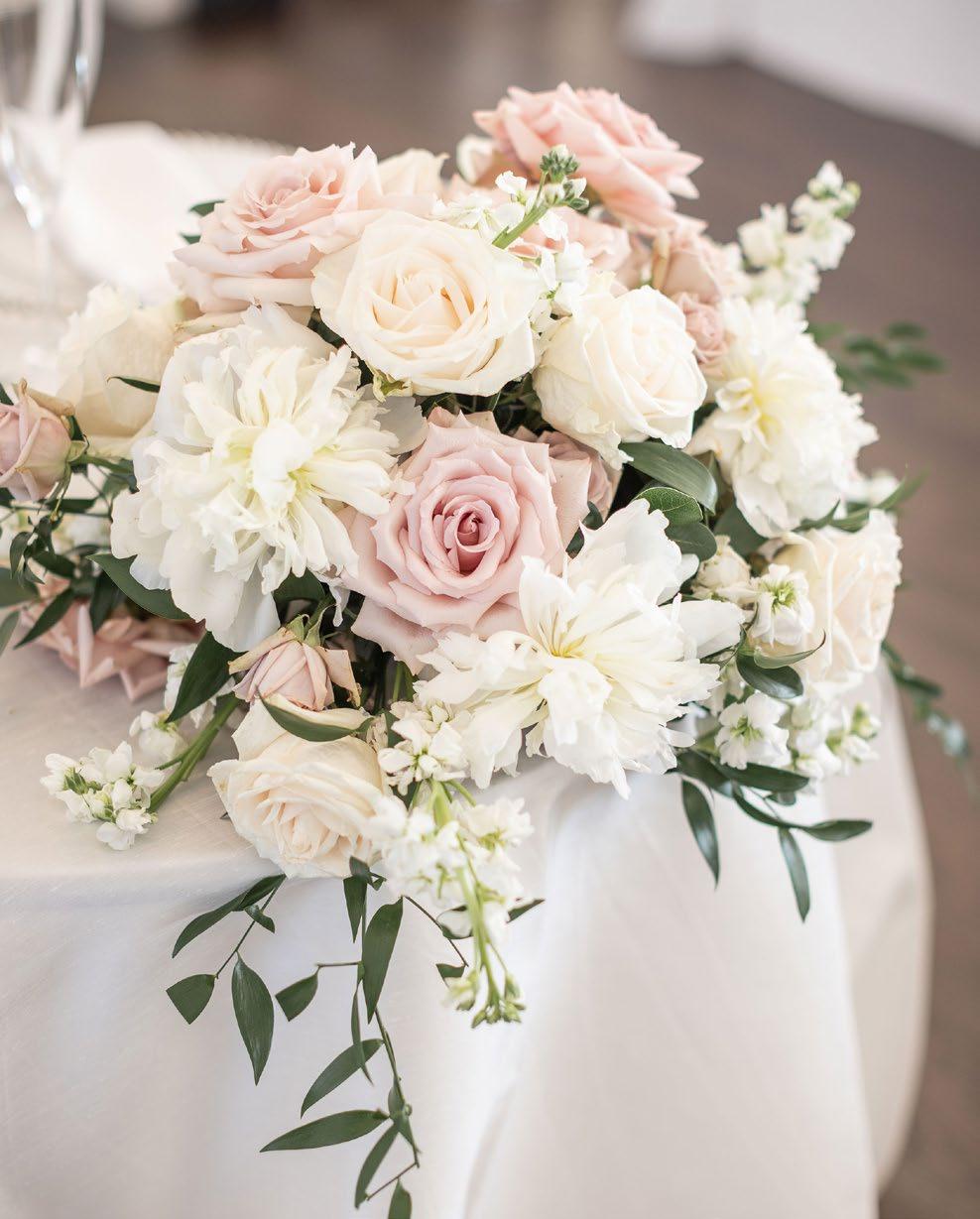
SPRING 2023 42 CHARITYHOPEPHOTOGRAPHY
DE TO TAUPE
In “Growing Wonder,” Felicia Alvarez of Menagerie Farm & Flowers muses on the versatility of roses she classifies as “multicolored and taupe.”
She wrote, “Like chameleons changing colors and tones with the seasons, the roses in this family are the most unique. From mauve to glossy purple, and a kaleidoscope of colors in between, the roses in this group always steal the show.”
Floral journalist Jill Brooke, creator of the blog “Flower Power Daily,” recently explored toffee and taupe-colored roses, calling them the new cultural rival of the ubiquitous red rose.
“These roses not only represent multi-colorism but reflect the growing trends in marriage,” she wrote, noting one international rose grower’s report that sales of “sand, toffee, and nude roses now make up 30% of the color assortment” of wedding flowers.
Floral designer Debbie Bosworth of Dandelion House Farm and Floral Design is also smitten with the neutral color spectrum. “I love trends that change, evolve, and adapt until they eventually become timeless,” she says. “The sandy-pink Quicksand rose and blushy-brown Cappuccino spray rose are two popular choices in the nude rose family and some of my favorites to work with when I'm designing a wedding with a soft, earthy, neutral color palette.”
‘HONEY DIJON’
As the darling of wedding and event floral designers, this rose’s unique mustard color and pink-streaked tips puts it in a class all by itself.
‘KOKO LOCO’
She almost needs no introduction – this crazy rose goes loco with shades of lavender-to-taupe while blooming. This rose is the sweetheart of floral designers and trendsetters.
‘DISTANT DRUMS’
As a beauty of an ombre rose, this is cherished by floral designers and gardeners alike. It produces flushes prolifically throughout the season, and is one of Felicia’s all-time favorite roses.
ORDER GROWING WONDER
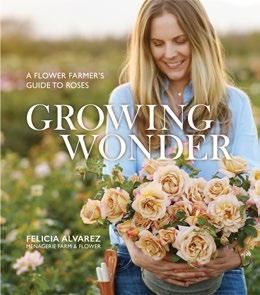
FLORAL DESIGN
Dandelion House Floral Design
dandelionhousefloraldesign.com
@dandelion_house
PLANNING: AMC Weddings
amcweddings.com | @amc.weddings
SLOW WEDDINGS O
A selection from Felicia’s “Multi & Taupe” garden rose recommendations in “Growing Wonder.”
SLOW FLOWERS JOURNAL 43
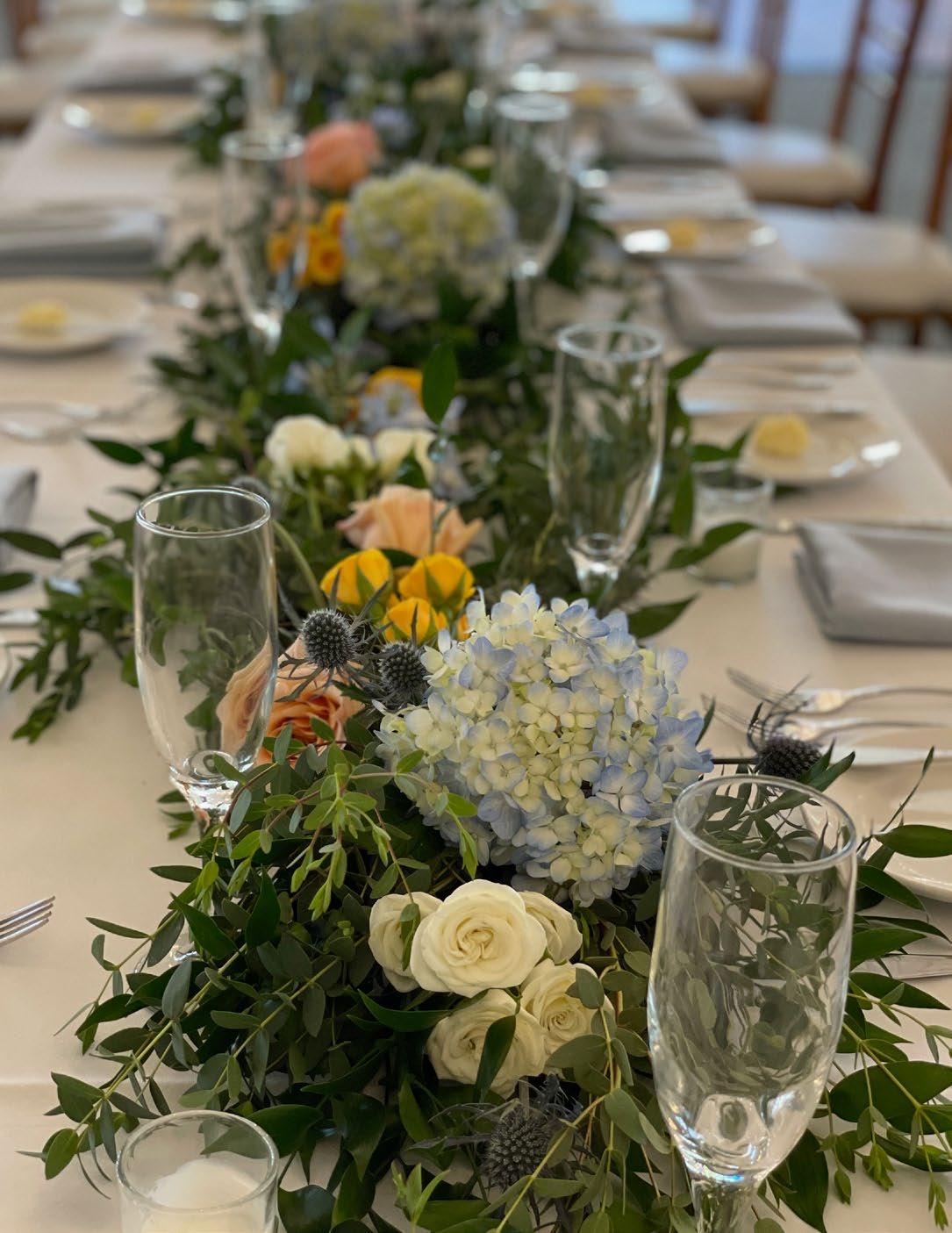
SPRING 2023 44 PHOTOGRAPHY BY ALISON ELLIS
destinations.
As a wedding florist, you want to stand out as the best choice for your clients. This sounds simple enough on the surface, but the trouble is, it’s not easy to carve your own path in the wedding business. Sure, there are some floral designers who seem to be overnight successes, creating great events and garnering a lot of press right from the start, but that’s an exception to the rule, not the norm. So how do you actually find a lane that’s best for you?
Most small businesses grow organically through word-of-mouth referrals where real clients rave about you to other potential real clients. This means if you’re looking for your own unique lane, it’s imperative that you listen to what your clients say that your company is doing especially well, and then figure out how to do more of that.
I’ve been specializing in destination weddings for more than 20 years; however, if that term conjures images of flying to a tropical island and eagerly awaiting a shipment of flowers at an airport terminal, that’s not what I mean! No, my clients are planning a destination wedding in Vermont, where I’m located, and it’s my mission to make choosing a florist easier for them.
I’ve learned to become intimately familiar with how the planning experience feels from my clients’ point of view. By leaning into the fact that I design flowers for out-of-town couples who are planning their wedding from afar, I’m able to give my customers better service, and that allows me to book them more easily, too.
When I ask myself, “what is my client experiencing?” the first
FIVE TIPS
Make booking a destination wedding special:
ONE
Put yourself in the shoes of your customers to understand their experience.
TWO
Look to your customer reviews for clues to what you’re doing well. Rinse and repeat!
THREE
Do more of the actions and activities that you identify as your strengths.
FOUR
Anticipate customer concerns about their destination wedding, and address those in your marketing and customer |service process.
FIVE
Decide to specialize in something that differentiates you, your studio, and your wedding expertise.
THE BUSINESS OF FLOWERS BY ALISON ELLIS
SLOW FLOWERS JOURNAL 45
Refine your niche and differentiate yourself as the go-to wedding expert for out-of-town couples
thing that comes to mind is, frankly, a lot of uncertainty! A wedding is a big deal after all – and it’s a lot of work to plan an event of such importance, even if it’s in your own backyard – so the distance of a destination event could feel daunting.
As I listen to customers say they’ve only been to their venue once and can’t remember all the details of the layout, or they love the idea of a destination wedding, but they hadn’t considered how time-consuming it may be to interview vendors (especially if they’re in a different time zone), I can begin to see things from their point of view and help address their concerns—both in my marketing and my client management.
My priority is to help customers feel confident that I’m the right florist for them. If they’re not familiar with the venue, it’s not a problem because I am. If they’re working with a short window for meeting vendors, I make myself flexible.
It goes back to Marketing 101: What is your client experiencing? What problems can you help them solve?
How can you do it better?
If you want to stand out as the single, best choice while you carve your niche as a wedding florist, learn to specialize in something. Listen to what your current clients are experiencing, and emphasize your strengths according to the rave reviews shared by past customers. You'll not only create your own lane, but you can continue to navigate your own path towards success with a clear direction of where you plan to go from here.

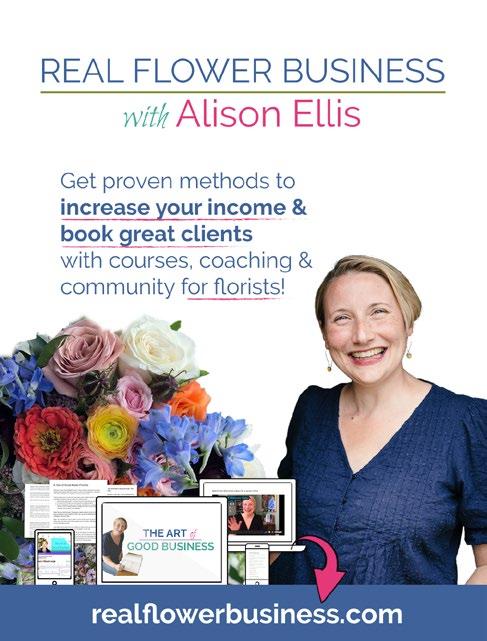
I make it my job to identify hiccups in the process faced by clients so I am able to create a smoother booking experience.
THE BUSINESS OF FLOWERS SPRING 2023 46 ORDER NOW! VISIT BLOOMIMPRINT.COM
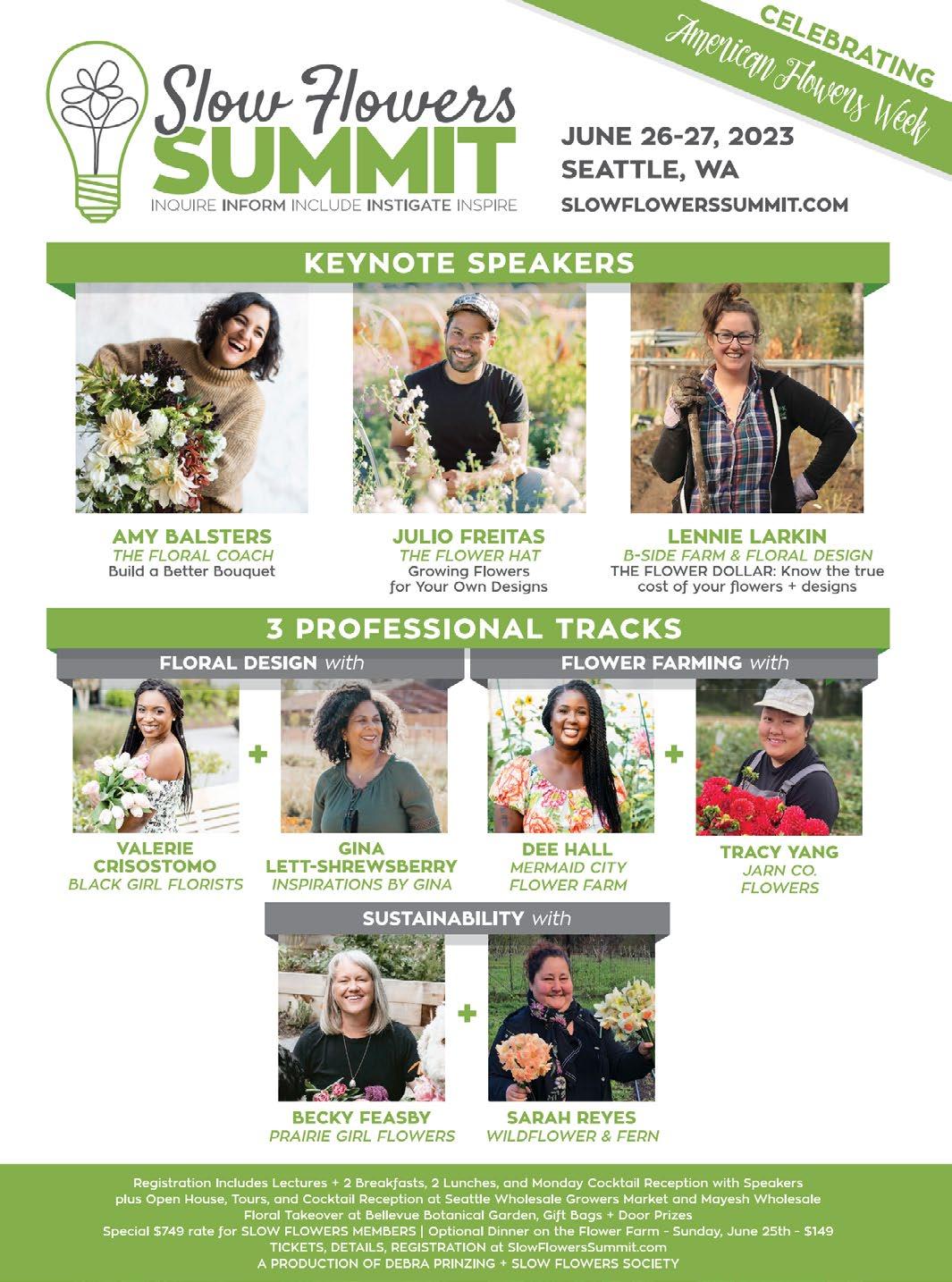
Her paintings were a lasting appreciation for the gardens that surrounded her.
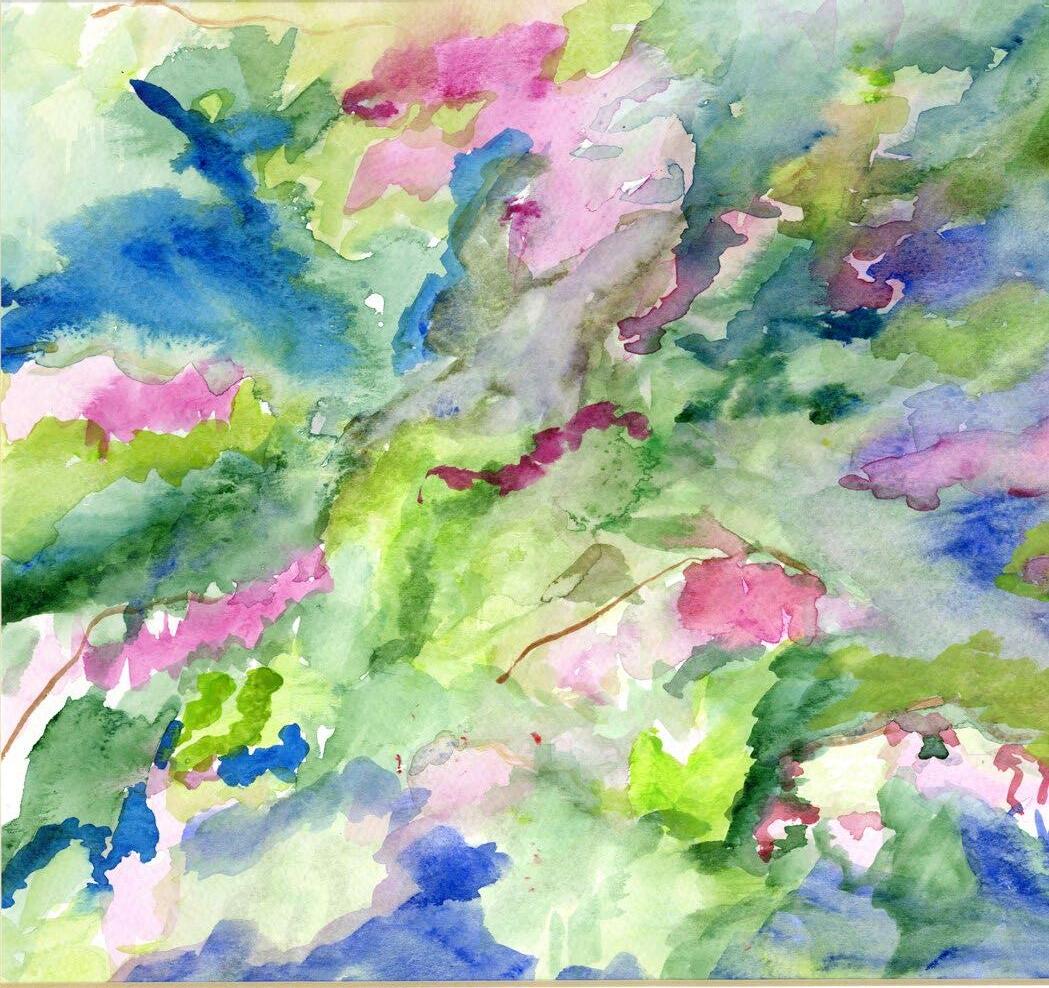
SPRING 2023 48
PAINTING BY PATRICIA LITTLEFIELD, PROVIDED BY THE AUTHOR
my grandma's garden.
In the language of flowers, the bearded iris represents hope and courage – both are trademarks of living a creative life. As I venture farther into the waters of creativity—and choose to follow a path that is anything but ordinary—I can’t help but acknowledge that my grandmother Patricia Littlefield and her gardens are what sparked this light in me. She instilled in me a belief that I could and should pursue a creative life.
My grandma wasn’t a gardener. She was an artist. Her gardens were her muse, her passion, and her delight. I was raised by her on the shores of Lake Michigan, among other family members, frequently spending time in the overflowing perennial gardens that surrounded her big blue house. We took trips to the local nursery each spring, looking for more inspiration to add to her cache; my grandma, waiting for a new flower to
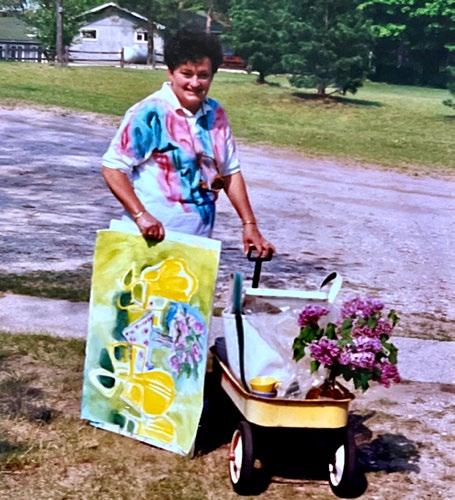
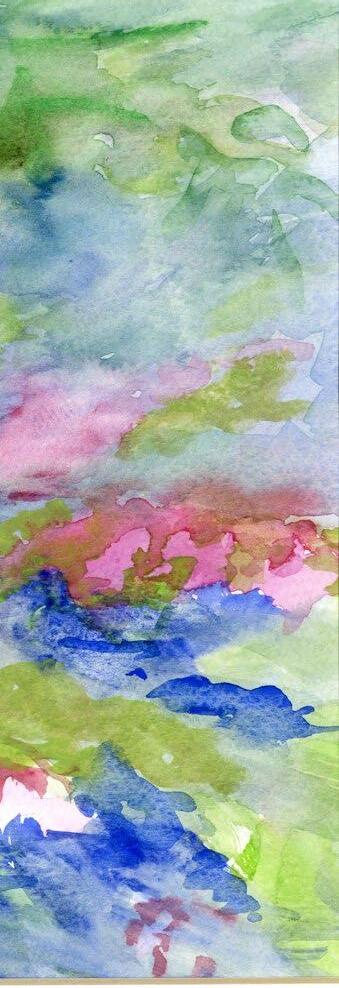
SLOW FLOWERS JOURNAL 49
FROM THE HEART BY MAYA LITTLEFIELD
speak to her, and me, patiently being pulled along in the nursery wagon, which was perfect for hauling plants and granddaughters. Her gardens contained multitudes of plants – bountiful and jungle-like in its design. In my memory, her flowers towered to 4- or 5-feet tall, but at the time, I was only about 2 1/2-feet tall myself. In reality, the gladioli and hollyhocks were nearly 5-feet tall, but I recall feeling small compared to the lilies, hydrangea, echinacea, and rudbeckia plants. I would weave in and out among the plants, inspecting their petals, pollen, and any visiting insects.
My grandma in her linen clothes, calmly and meticulously setting up her easel among the irises, carefully unpacking her art supplies one tube of pigment or brush at a time. I am always reminded of these voluptuous, bearded irises towering above the rest of her June garden. Atop their slender stems and reed-like leaves, sat puffs of pastel colors with billowing, ruffled petals blowing in the breeze.
She could happily sit here for hours painting her blossoms plein air-style, only stopping to make me mac n’ cheese or harvest a handful of blooms, placing them in a glass vase to be painted later.
She would always invite me to paint with her, generously sharing her professional-grade art supplies with me: $12 tubes of gauche, thick watercolor paper, pristine canvases, and pastels. We would spend hours painting together – her examining how the light hit each petal and replicating each shade of peach or mauve perfectly, while I painted triangular people with fingers like French fries and two strands of hair.
As her children grew up and left the house, she replaced their presence with her colorful depictions of gardens and vases brimming with blooms. She allowed flowers to create abundance, while she transitioned from motherhood to life as an empty-nester and divorcée, and then slowly into grandmotherhood. Her paintings were a practice. She never intended to sell them, only to use them as a means to create a lasting appreciation for the temporary beauty of the gardens that surrounded her.
As I began to realize my own interest in flowers, my grandma got sick. Her day-to-day life slowed and her ability to garden lessened. I helped her plant zinnias and cosmos around her back patio so she could sit and paint them – appreciating their delicate details. I would deliver arrangements to her house and she would paint them for me—her watercolor strokes and color choices perfectly depicting the splendor of the farm-fresh blooms—so real that you could almost smell her muscari and peonies.
My grandmother passed away last December, leaving a mountain of her paintings to her five children and 11 grandchildren, including me. Her work was so infused in my life that I have had to take a step back to reflect and realize that my own love of art and flowers stems directly from my time spent with her as a child. Over the years, her artwork contained an expanse of flowers, but the bearded iris still stands out to me as her flower. Its representation of hope and courage perfectly exemplify her outlook on life and her dedication to living a creative and rich life.
SPRING 2023 50
FROM
THE HEART
SLOW FLOWERS PODCAST HIGHLIGHTS
top five.
Slow Flowers Podcast Episodes (February – April 2023)
EPISODE 605 | APRIL 12TH
The Color of Roses with Rose Story Farms’ Danielle Hahn.
WATCH HERE
EPISODE 604 | APRIL 5TH
Sustainable Design for Event Florals with Ingrid Carozzi of Tin Can Studios.
WATCH HERE
EPISODE 601 | MARCH 15TH
Meet Rita Feldmann of the Sustainable Floristry Network, a new global education organization for florists.
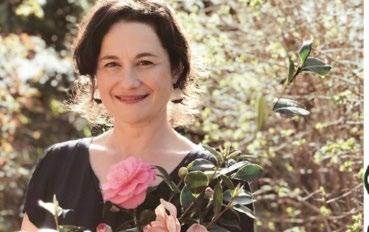
WATCH HERE
EPISODE 599 | MARCH 1ST
Sustainable Luxury Floral Design with Susan Chambers of San Francisco’s bloominCouture.
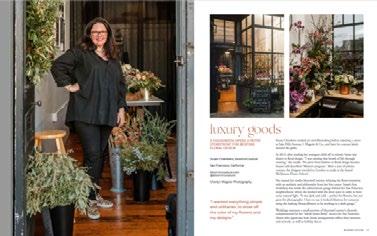

WATCH HERE
EPISODE 597 | FEBRUARY 15TH
All about the new Black Florists Fund, and a conversation with its founders and first grant recipient.
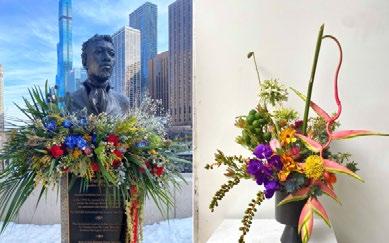
WATCH HERE
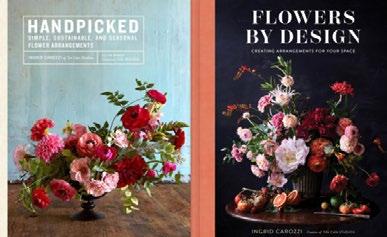
SLOW FLOWERS JOURNAL 51
slow flowers in australia
Lessons learned from flower farmers across the ocean

There is so much to learn, to experience, and to explore when we are open to the gifts of Mother Nature. She teaches me something new each day, in every season. As a flower farmer and gardener, that’s what it’s all about. I watch my mentors and leaders in the floral community, and I do my best to soak it all in. Someone recently commented on one of my Instagram posts, “Enjoy your twenties and learn as much as you can, because they fly right by.” Well, for me, that’s the goal!
A little flower farm in Oregon is home, and a few months ago, my cousin Rilley Syphers and I followed a dream – to skip winter and travel Down Under. Thanks to the beauty of social media, a generous soul named Ashlea Ranken of Yellow House Flower Farm in Hexham, Victoria, Australia, invited us to stay at her family’s sheep and flower farm. She also arranged for us to visit two other Aussie flower farms. The experience was life-changing and inspiring!
In the Dja Dja Wurrung countryside, a region in central Australia, we sat down together with a cuppa in hand, excited to share our experiences and knowledge with fellow flower farming enthusiasts! Janae and Chris Paquin-Bowden from Fleurs de Lyonville welcomed us into their floral world. We laughed about our mutual experiences, trials and errors, traded helpful tips, and shared future goals with each other, but there were a few main insights that truly inspired us.
Chris asked, “Can you imagine what roses have to be treated with in order to be approved for import?” He and Janae told us about a florist who said her hands burned after working with chemically treated imported roses. Many gardeners and farmers are aware of the environmental issue of flowers flown in from other countries, but there is still a huge need for education. There are many
CHECK OUT
EMMA'S INSTAGRAM
RILLEY'S INSTAGRAM
SPRING 2023 52
FLORAL RETREAT STORY + PHOTOGRAPHY BY EMMA MAY DIXON
RILLEY + EMMA Cousins Rilley Syphers (left) and Emma May Dixon (right) grow flowers and design weddings together at Crowley House Farm in Rickreall, Oregon. Emerging voices in the Slow Flowers Movement, they love sharing their adventures with fellow "bloomers," fans of "A Blooming Good Time" podcast.
PODCAST


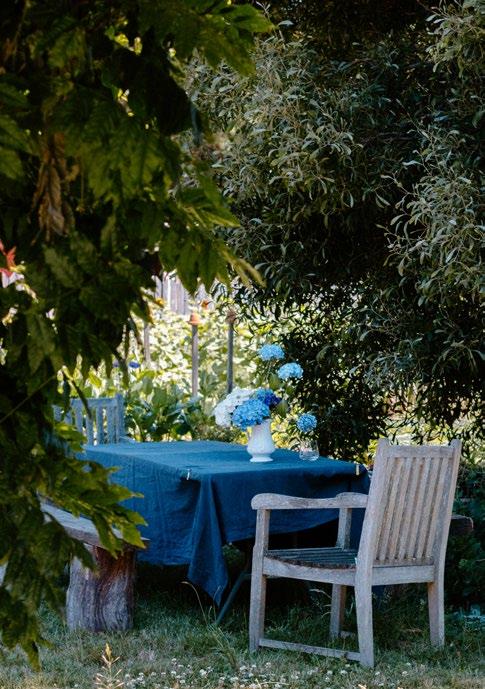
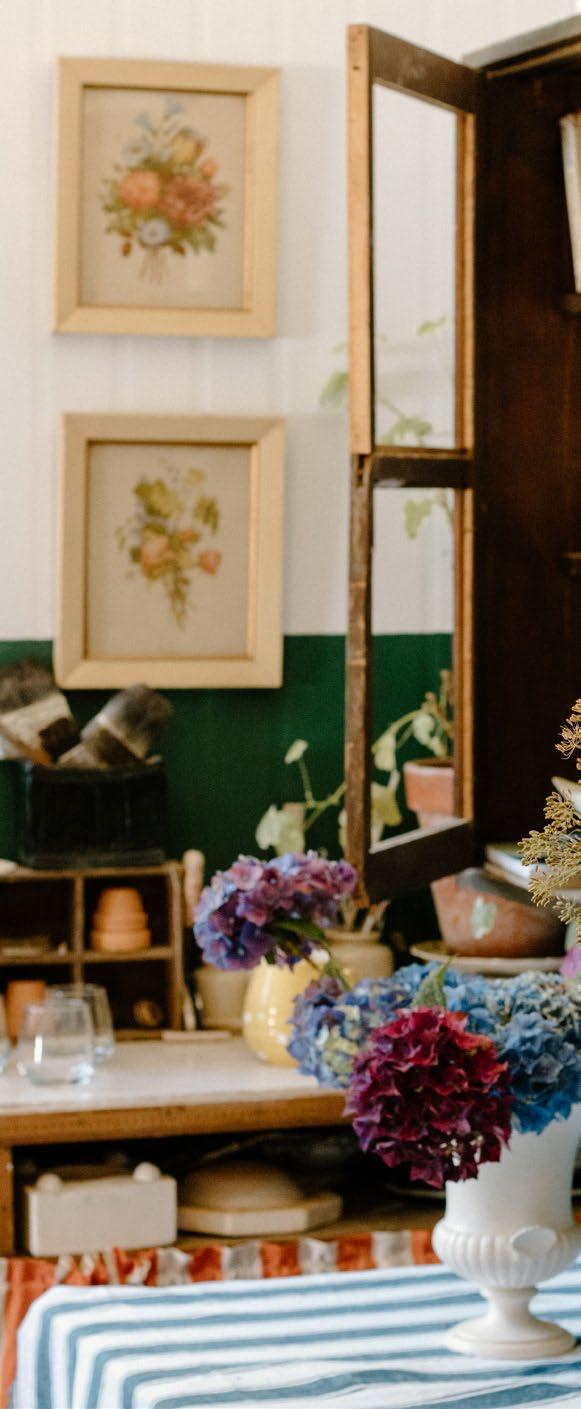
SPRING 2023 54
reasons to buy locally, but awareness is on the rise in Australia, thanks to farmers like Janae and Chris, who use their flowers to teach and educate.
We also visited Lorelie Merton of Florelie Seasonal Flowers, based in Bungaree, Victoria, Australia. Lorelie specializes in dahlias and introduced us to an entire new way of flower farming. There are farmers who sell seeds and bulbs, or those like me, who sell cut flowers. Lorelie produces and sells dahlia tubers, and she mostly focuses on dahlia breeding. How amazing to be able to name a dahlia variety that you created! We were so inspired by Lorelie's accomplishments. The story of her successful business shows us that there truly is room for all kinds of flower farmers, and that the floral community is an important source of support and respect for one another.
Janae mentioned living by the motto, “What comes around, goes around.” When she and Chris wanted to learn from someone they admire, they offer to help by volunteering their labor as interns, learning by working.
Janae also supports her friends and other small businesses by posting their products on her social media account, or making client referrals as a way to support and help cultivate a healthy floral community.
After returning home to Crowley House Farm, I’ve been thinking of ways I could implement these lessons and incorporate them into our flower farm. Though we are an ocean apart from our Australian flower farmer friends, we face similar challenges. Farming can be a hard and lonely profession, which is why nurturing community and sharing education is so important. Not only do we learn from the nature that surrounds us, we also learn from the people who work alongside us.

SLOW FLOWERS JOURNAL 55
FLORAL RETREAT
Being so generously welcomed by Australia’s flower farming community has inspired Rilley and I to emulate our experience here at home.
FLORA CULTURE PHOTOGRAPHY BY MISSY PALACOL
the art of paj ntaub.

monroe, washington
Hmong embroidery as floral inspiration.
Flower farmer Tracy Yang grows seasonal specialty-cut blooms with her partner, Nick Songsangcharntara, on land in Monroe, Washington. The name of their third-year farming enterprise, JARN Co., is inspired by the English Romanization of the Thai word that translates as “moon,” and is also a root of Nick’s surname.
People who fled Laos during the Vietnam War are part of the Hmong Diaspora, including Tracy’s parents. They lived in Thailand as refugees before migrating to the U.S. in 1979, settling in Minnesota, where there is a sizeable Hmong community.
As a teen and young adult, Tracy competed and performed hiphop dance, and later supported herself as a fitness coach, as well as massage therapist. In 2020, the COVID-19 pandemic forced Tracy to stop her one-on-one client work. Instead, she helped deliver flowers for her sister’s Seattle-
area farm and started apprenticing there, learning how to grow flowers from her mother, Mama Yang.
“Farming with my mom was an important connection with my Hmong heritage, and I absorbed much about my culture, and about my mother and father’s Hmong immigrant experience,” she said. “She taught me much about being Hmong-American and that our culture, the beliefs, the values, and the rituals are all rooted in agriculture.”
Until she was in her thirties, Tracy thought of gardening in terms of her father, who landscaped their yard and maintained the family’s quarter-acre vegetable patch in Minnesota. He passed away when she was 13, but Tracy said she often wonders, “What would he think about flower farming? I think he would absolutely love it. It’s something my mom and I talk about a lot when we’re in the field together. Every once in a while, she'll mention it and say, ‘flowers always make me think of your dad.’”
Tracy’s boyfriend, Nick, provided his own endorsement of flower farming, Tracy said. As an extrovert, Nick loved interacting with customers when he helped to sell flowers at the farmers’ market for Mother’s Day. “He thought it was fun,” she laughed. “I never intended to grow flowers and I knew it wasn’t easy, but his enthusiasm made me reassess.”
Joining Mama Yang at her sister’s farm in Carnation introduced Tracy to methods and techniques of market farming. “I wanted to work alongside my mother that first season, before I made any final decisions about jumping into flower farming,” she said.
Through Hmong embroidery art, Paj Ntaub, which translates as “flower cloth,” Mama Yang helped Tracy make beautiful connections between her Hmong heritage and her floral creativity. “I asked her one day when we were at the farm stand, ‘How did you learn to
SPRING 2023 56

SLOW FLOWERS JOURNAL 57
make bouquets?’ She said that her experience with embroidery helped her grasp the concept of bouquet design.”
With detailed patterns made by colorful threads that cover the surface of special embroidery cloth, the pieces are more than artwork. “The Paj Ntaubs are also part of Hmong storytelling, sharing folklore about Hmong life in Thailand and Laos. They are really fascinating and give me insight into how my parents lived, how they grew up, and what they went through before moving here to America,” Tracy explained.

In 2021, Tracy and Nick formed JARN Co. and leased a small parcel of land to get started. They specialize in growing high-value bulb flowers like tulips and dahlias, but also raise plenty of annuals and foliages to round out their bouquet designs. Most of their flowers are sold to professional florists who shop at the Seattle Wholesale Growers Market. In addition, they bring blooms to several area farmers’ markets, and run a local CSA program.
One of the Paj Ntaub designs is called “Lub Tsev,” which Tracy said means “The House.” “Again, this refers to our
agriculture roots. It refers to the little farmhouse or even a familial house, which is a big part of the Hmong culture and lifestyle.”
While she and Nick are intent on building JARN Co. into a successful business, growing flowers is deeper than an entrepreneurial exercise, Tracy observed. “I didn't think about my Hmong heritage for a long time, but working alongside my mom was a full-circle moment for me. And I have realized, I'm right where I need to be.”
FLORAL FASHION SLOW FLOWERS JOURNAL 58
WEBSITE | INSTAGRAM
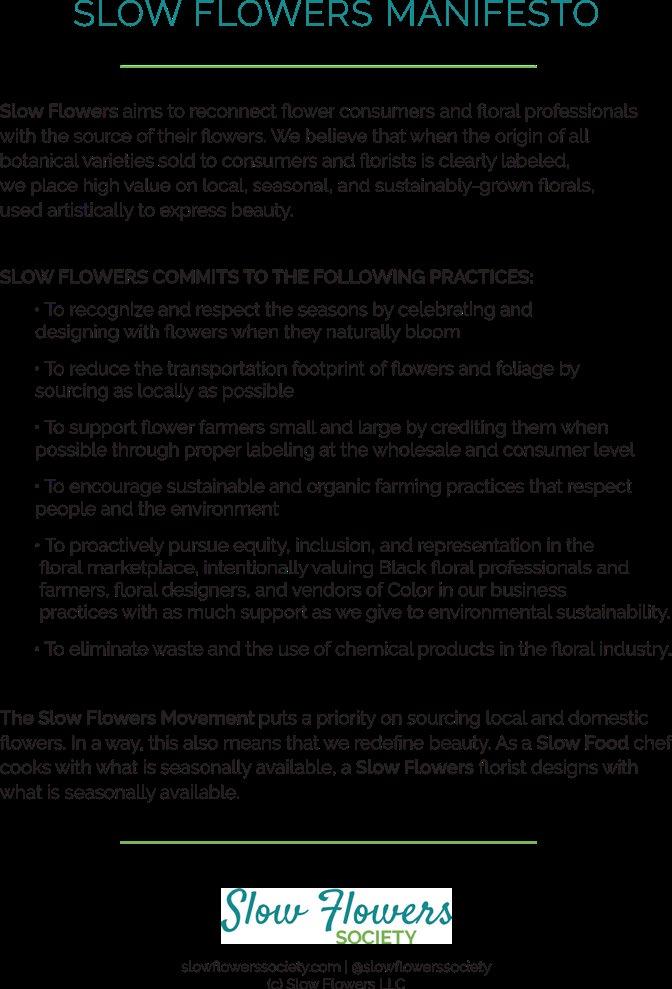
SLOW FLOWERS JOURNAL 59
BLOOM identifies and develops projects that shine a light on the floral lifestyle, showcasing the stories of floral personalities, creatives, entrepreneurs, farmers, and artisans.
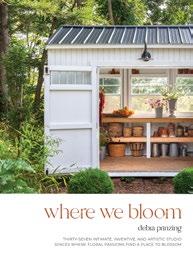
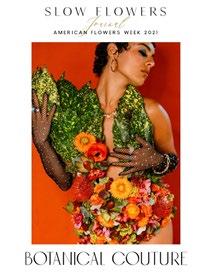
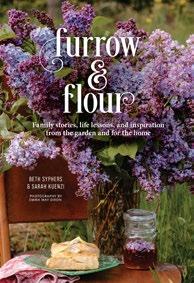
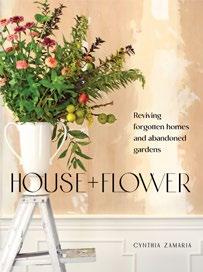

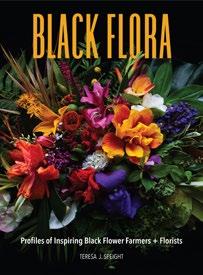

OUR BOOKS FEATURED IN






BOOK DEVELOPMENT + EZINE PUBLISHING













Founded in 2020, BLOOM engages readers to experience a new relationship with flowers, inspiring them to embrace local, seasonal, and sustainable practices. Our publications reveal the voice and vision of our authors and writers, pairing their written narratives with beautiful imagery and strong graphic design concepts. Located in the Pacific Northwest, the company works with a variety of creativies on the development and/or production of books, magazines, and specialty publications.

about BLOOM Imprint
BLOOMIMPRINT.COM | @BLOOM.IMPRINT | BLOOM@BLOOMIMPRINT.COM



















































































































